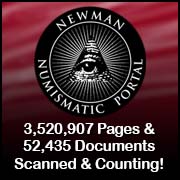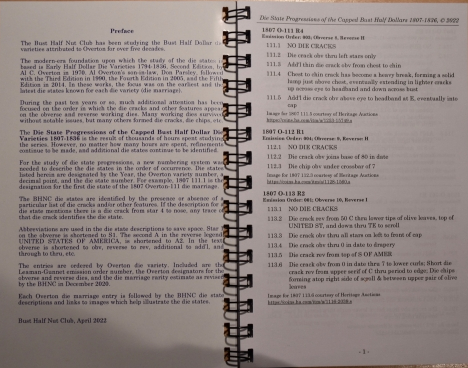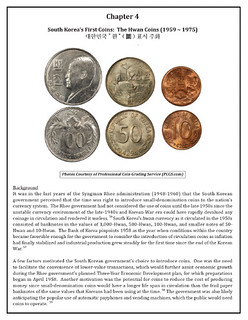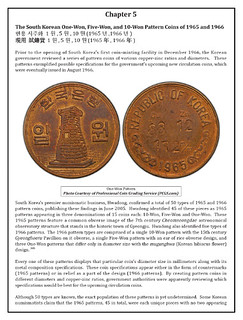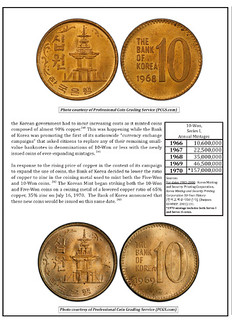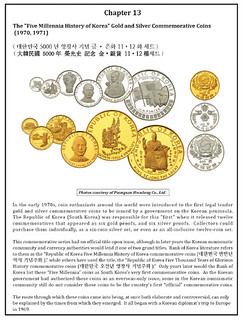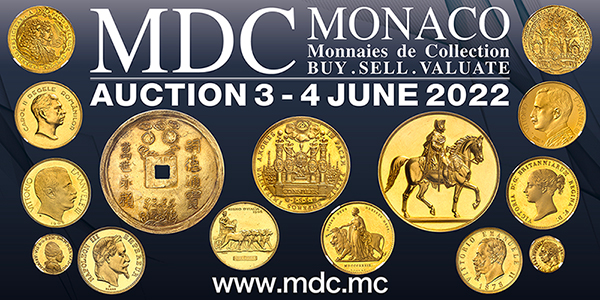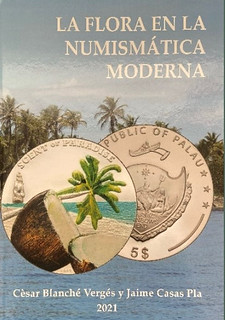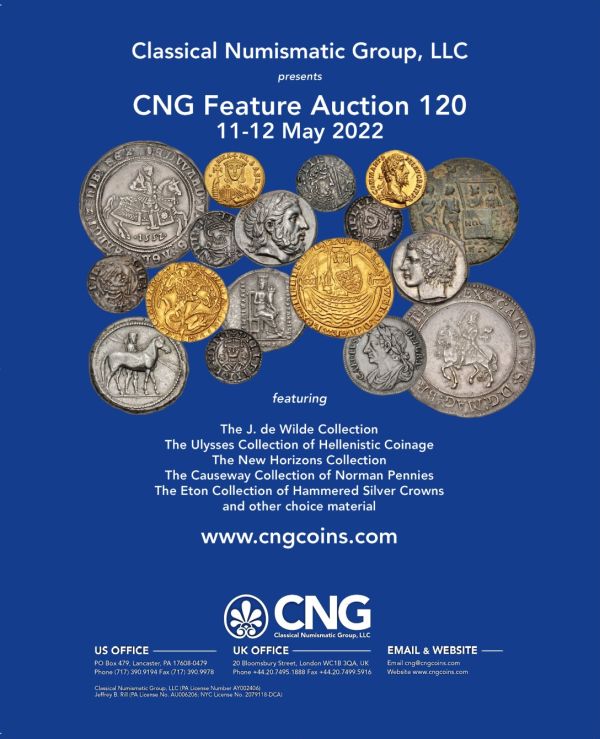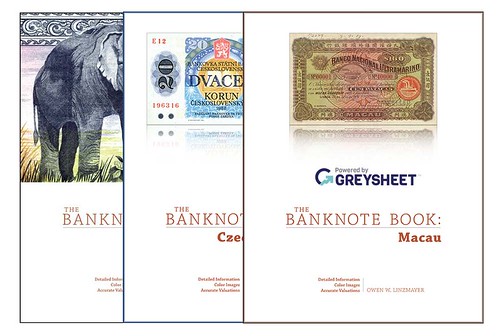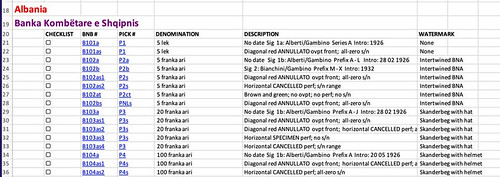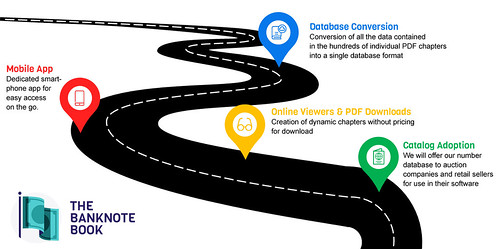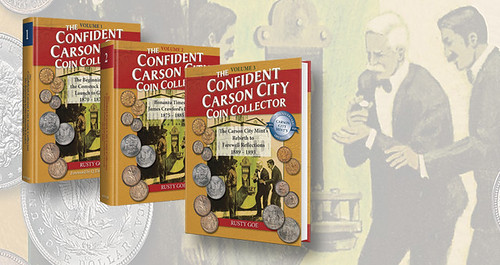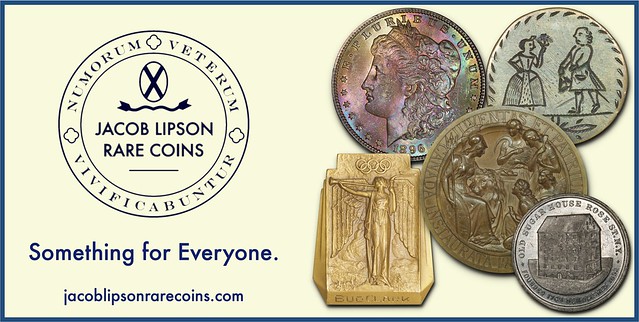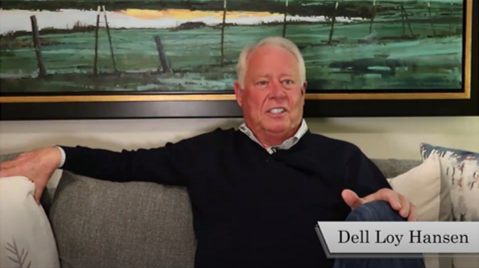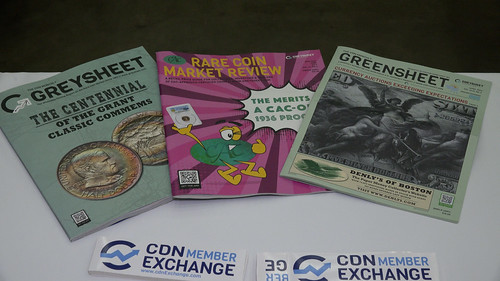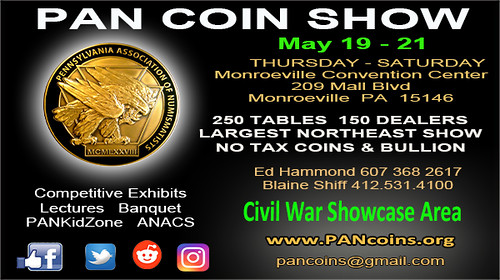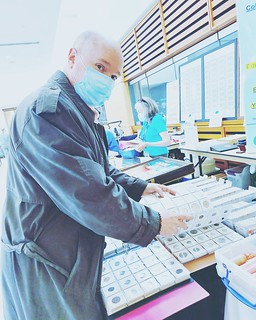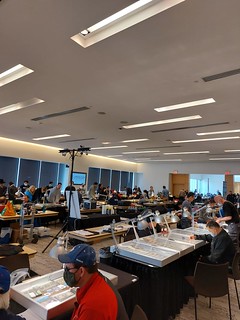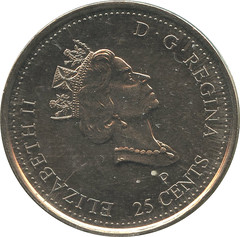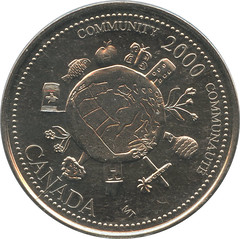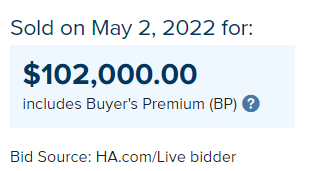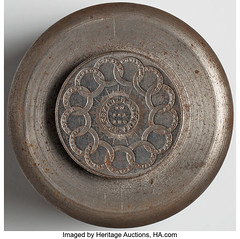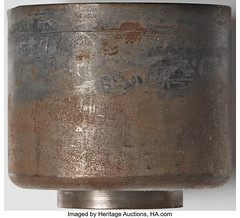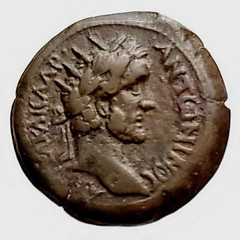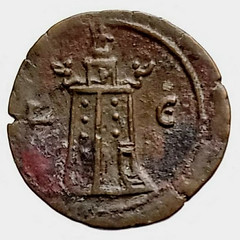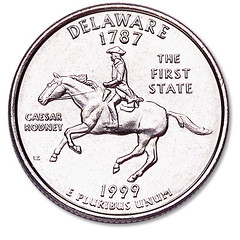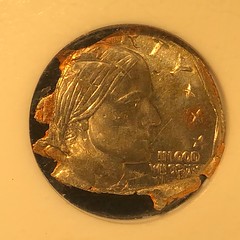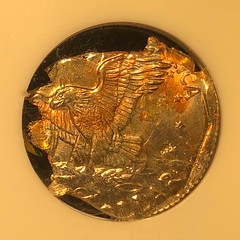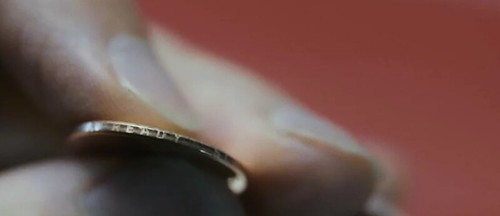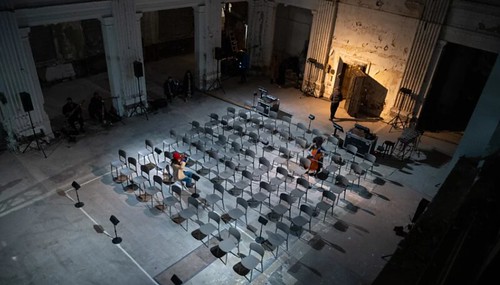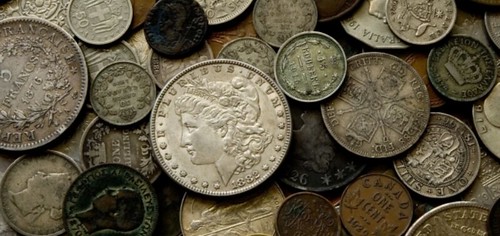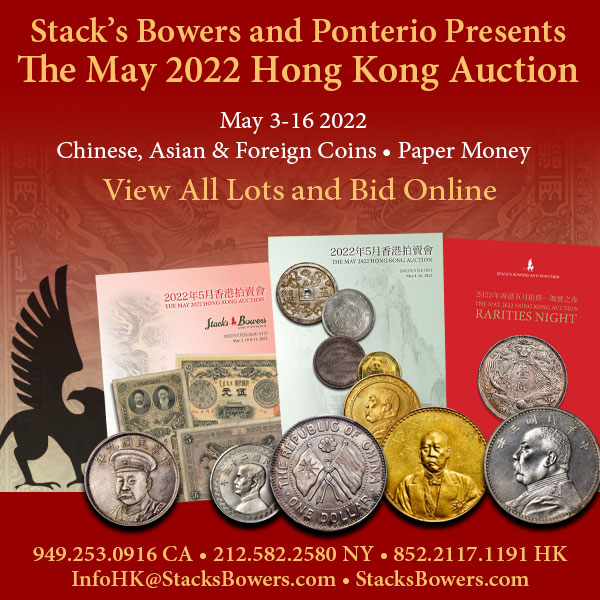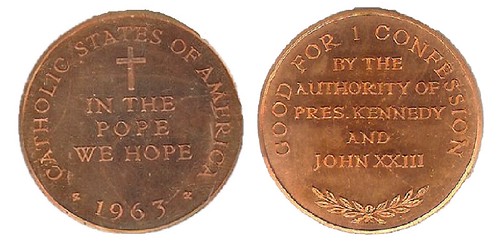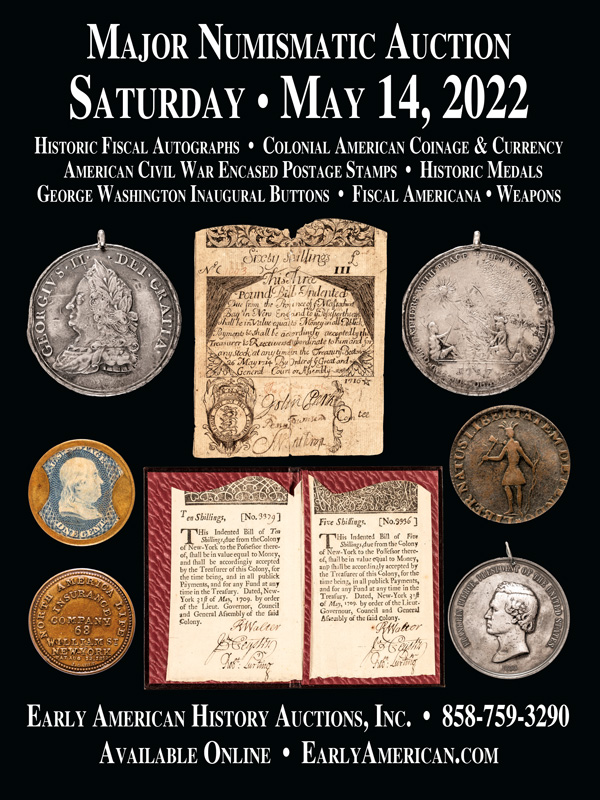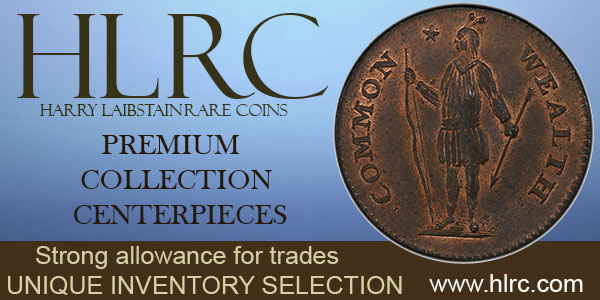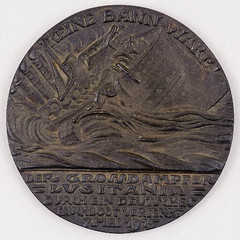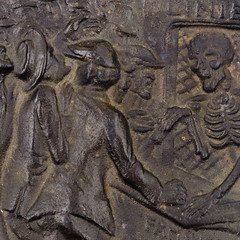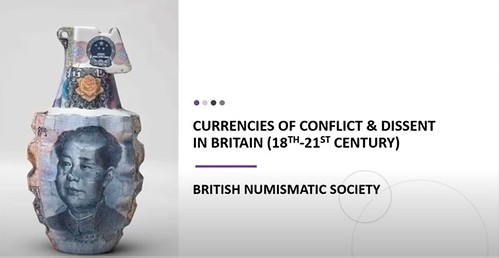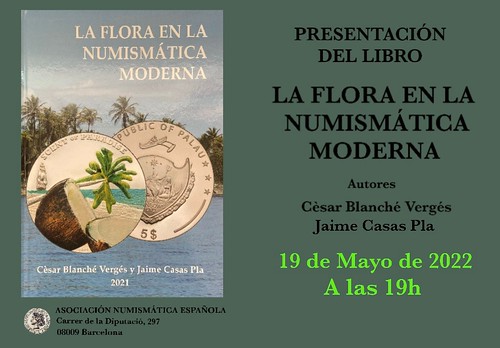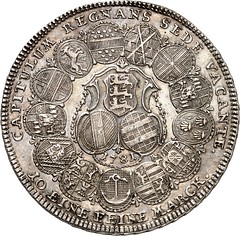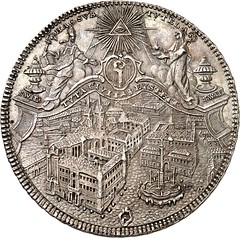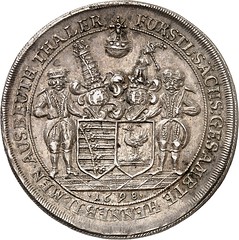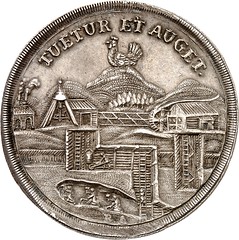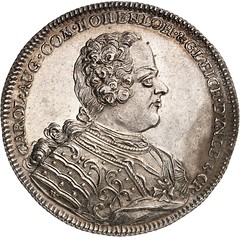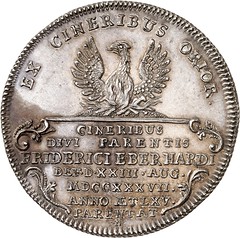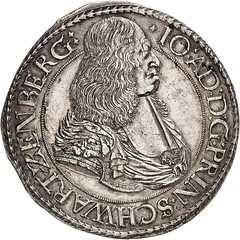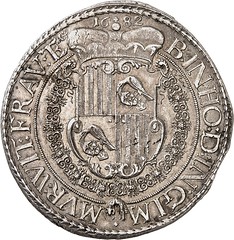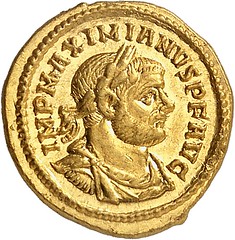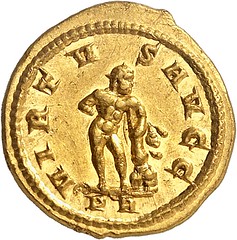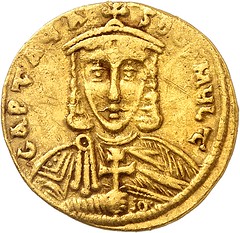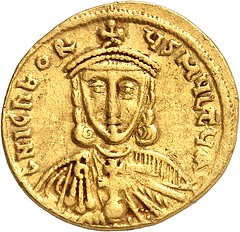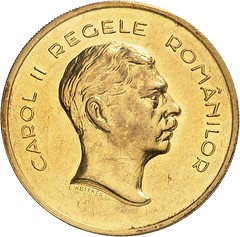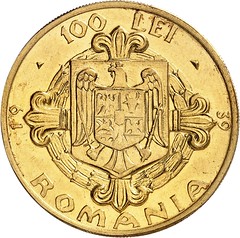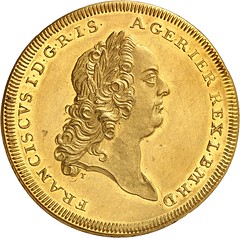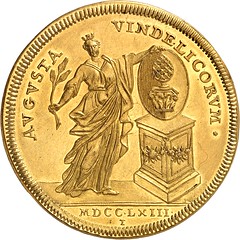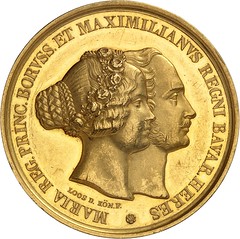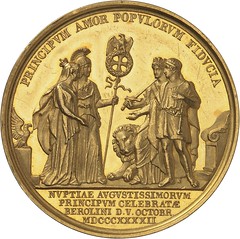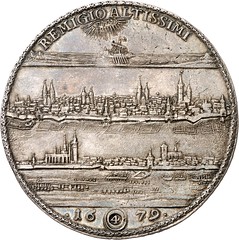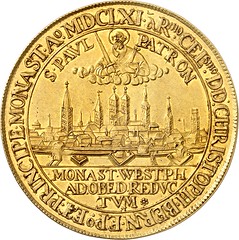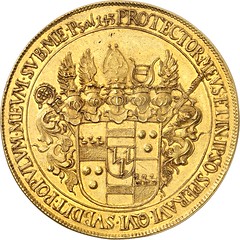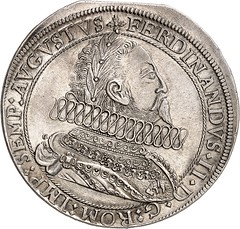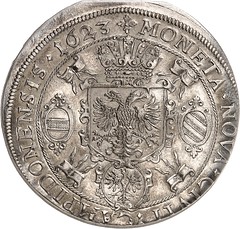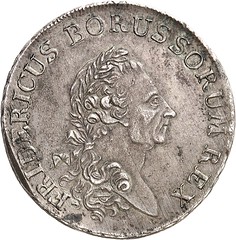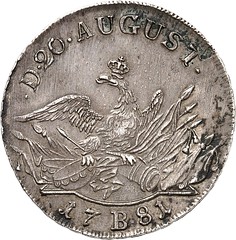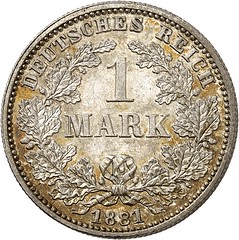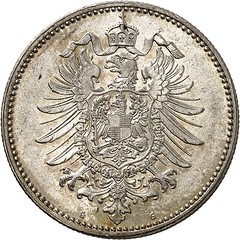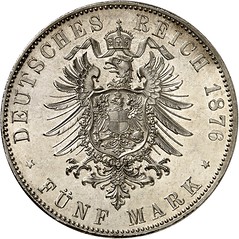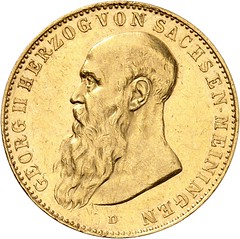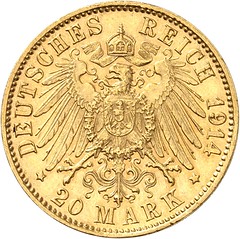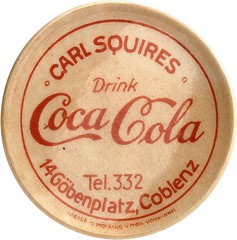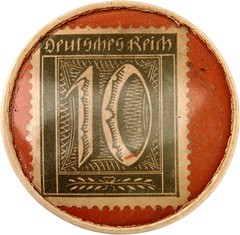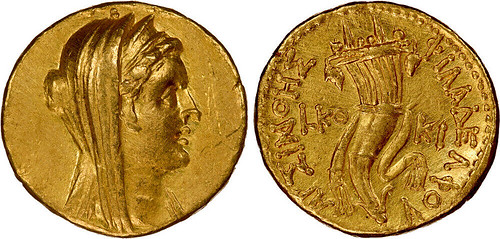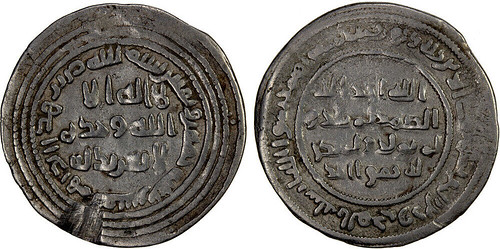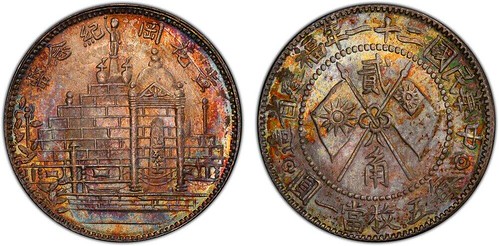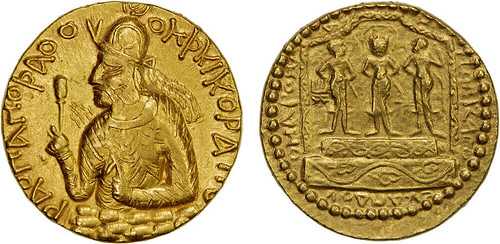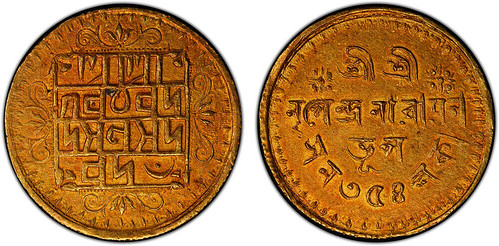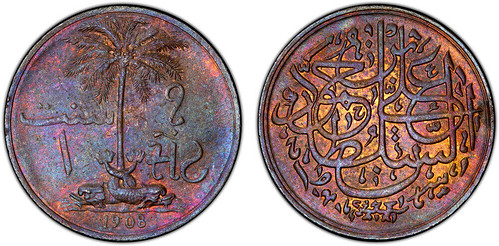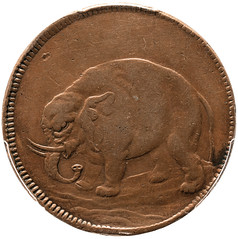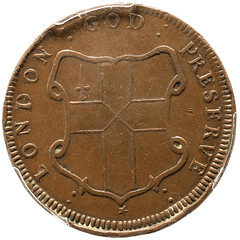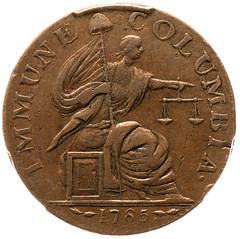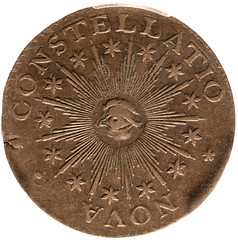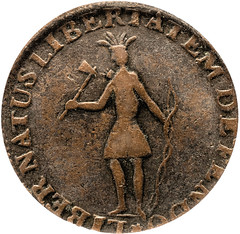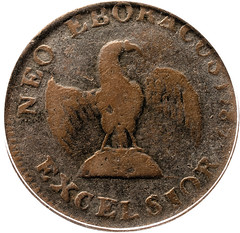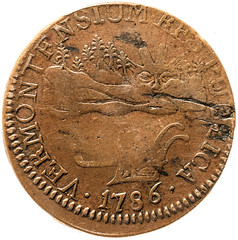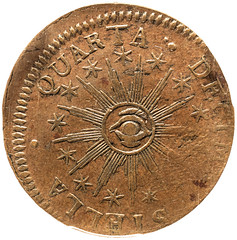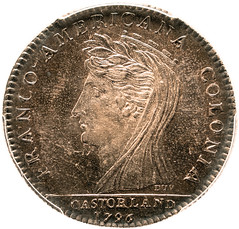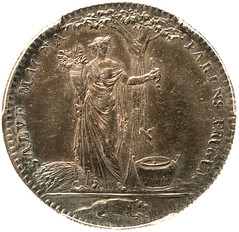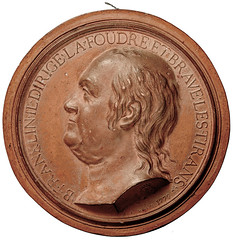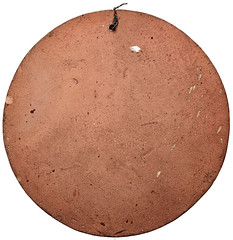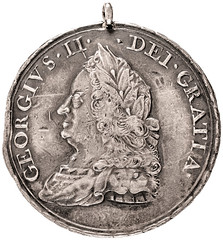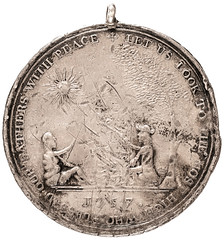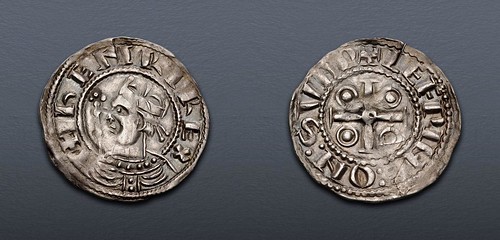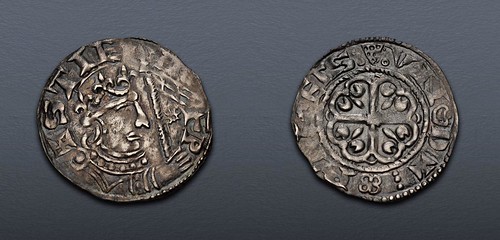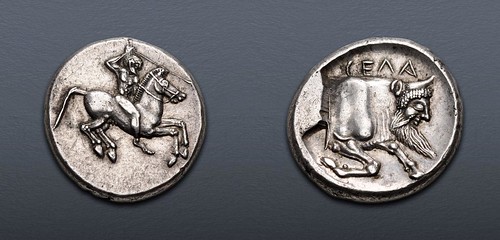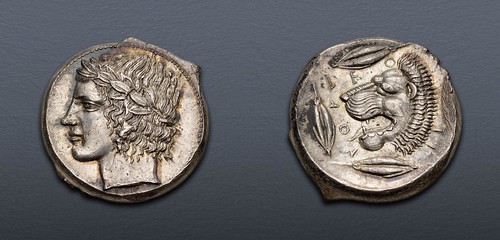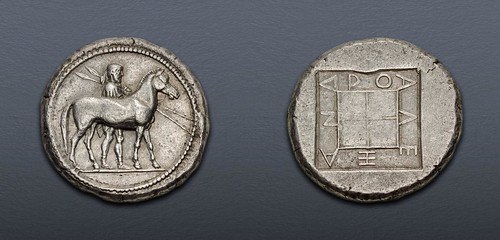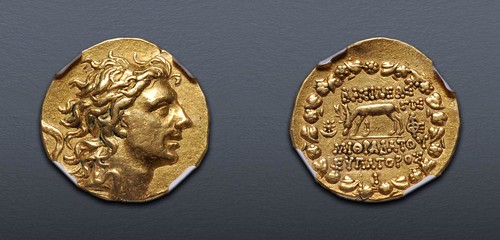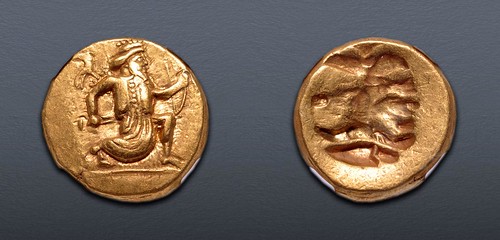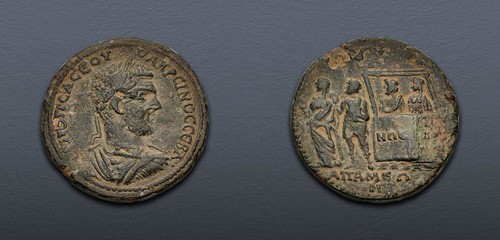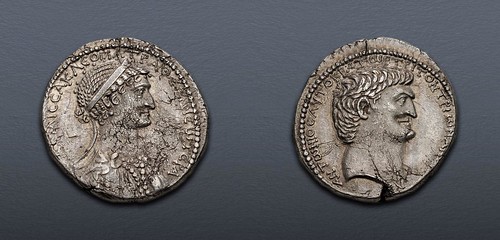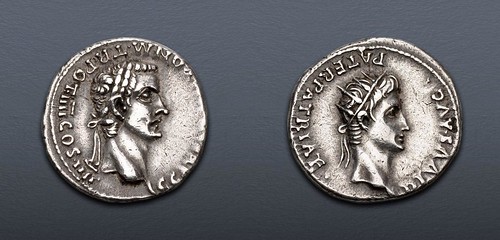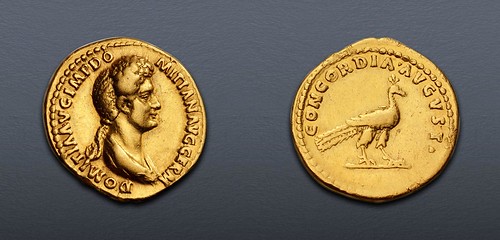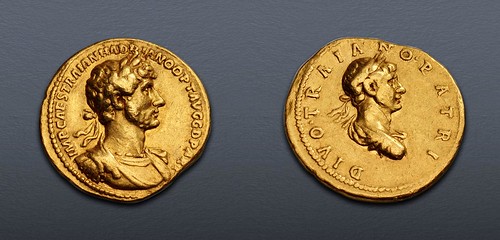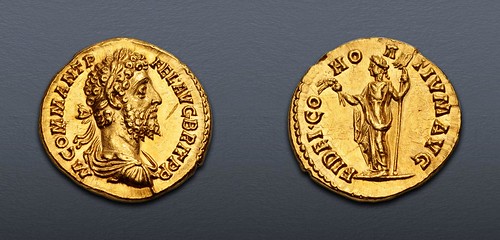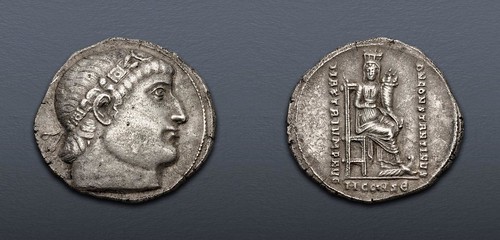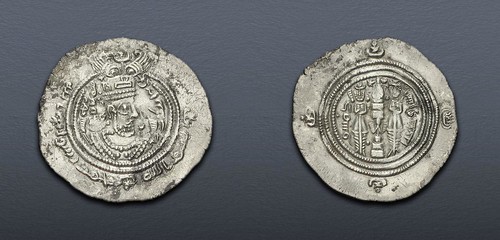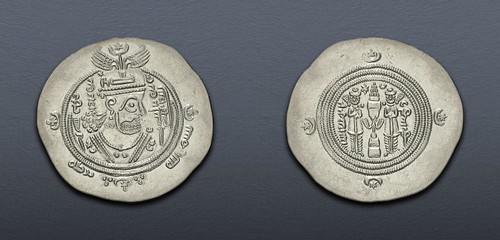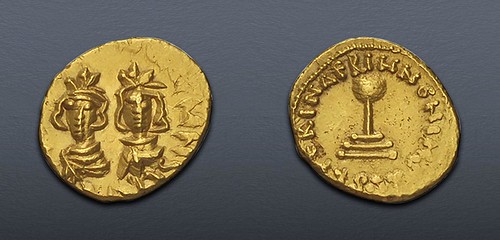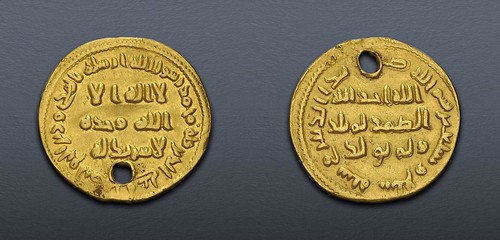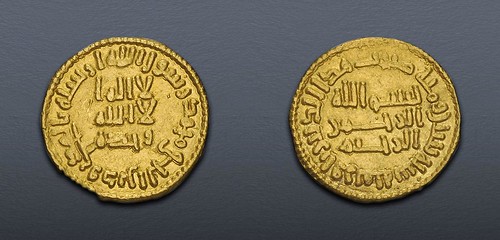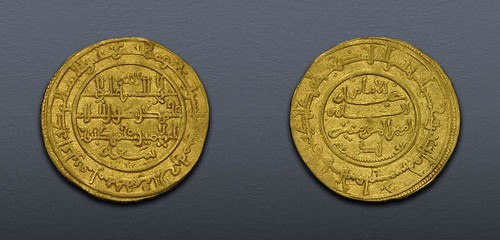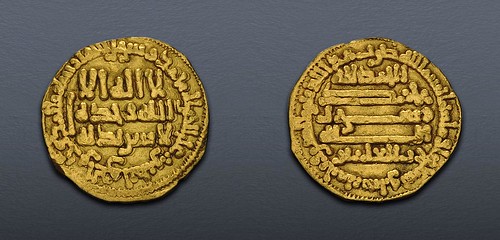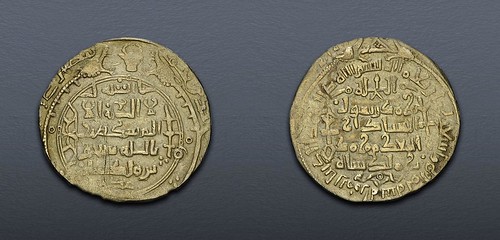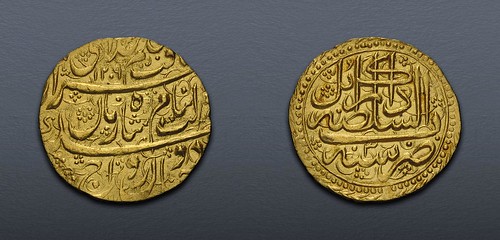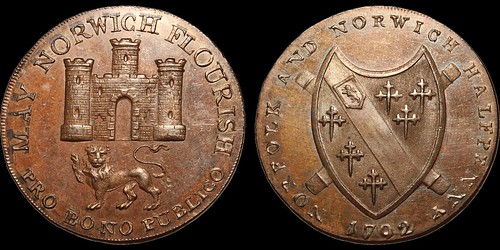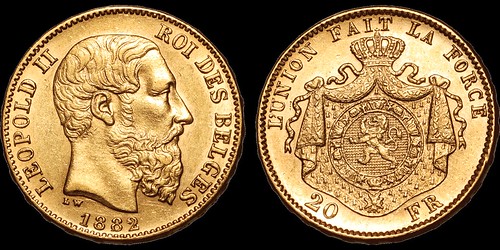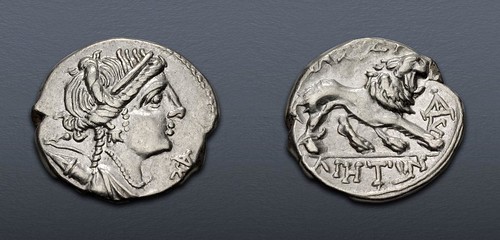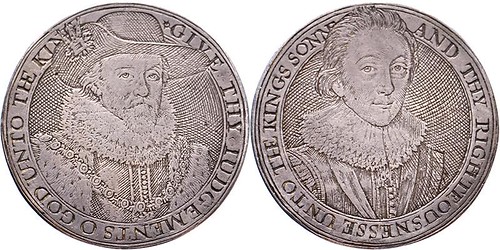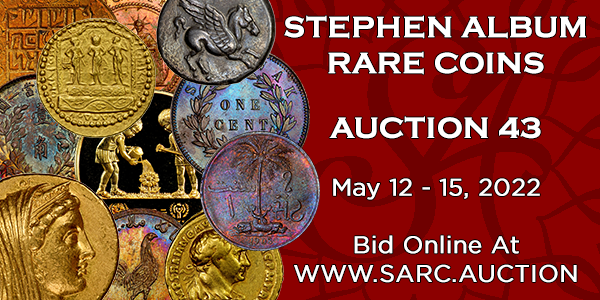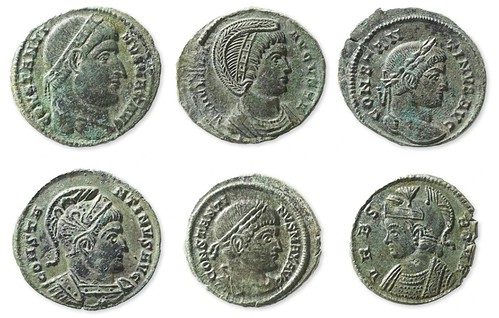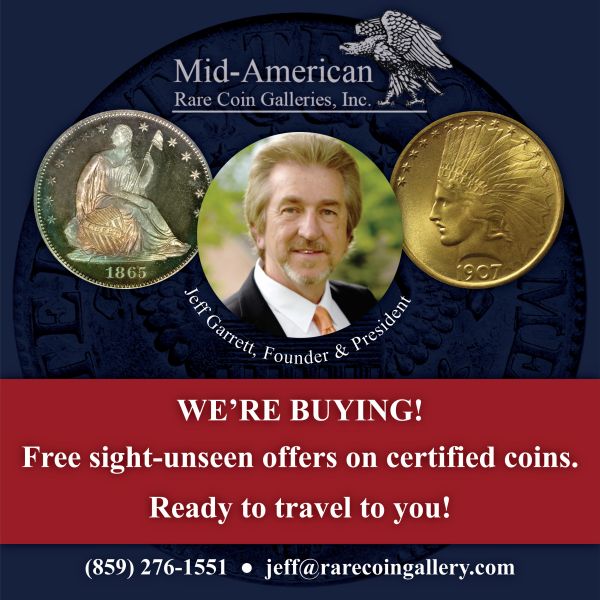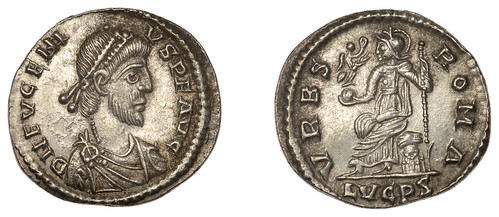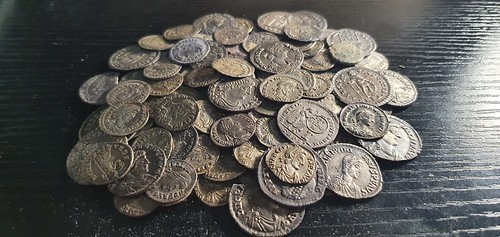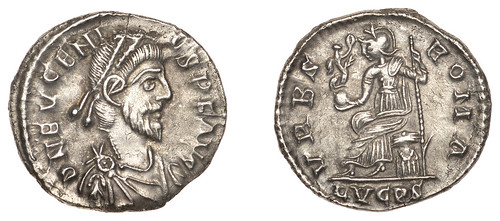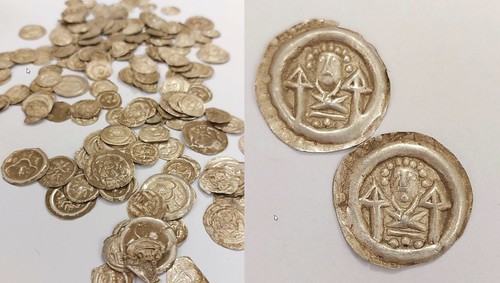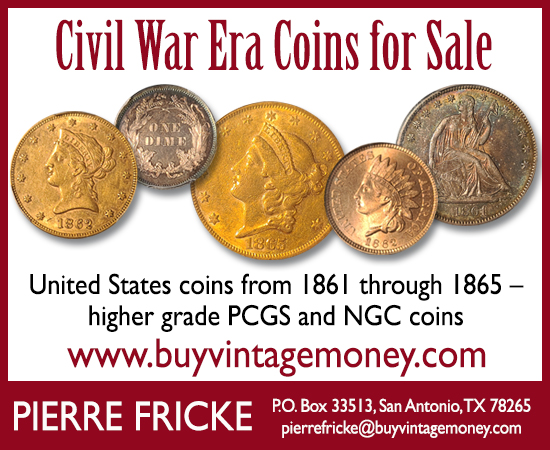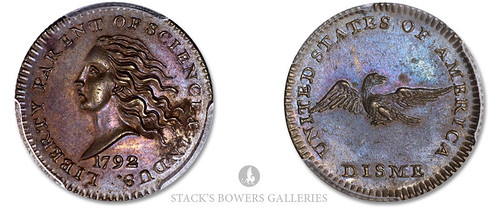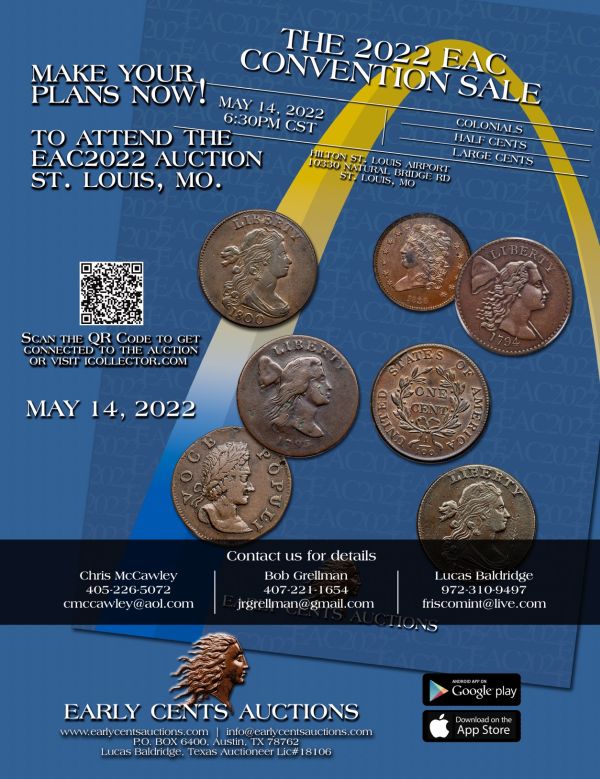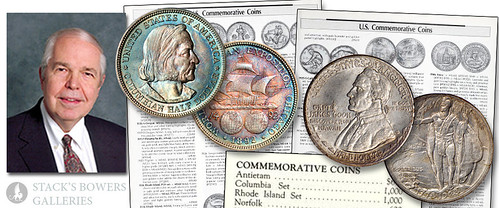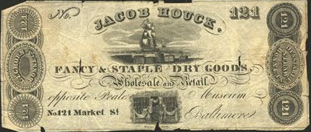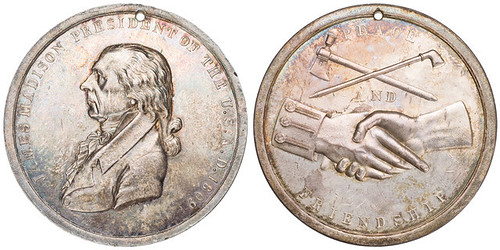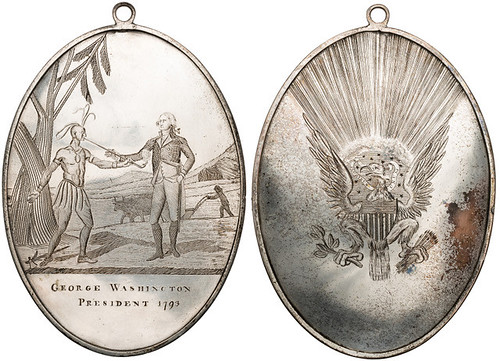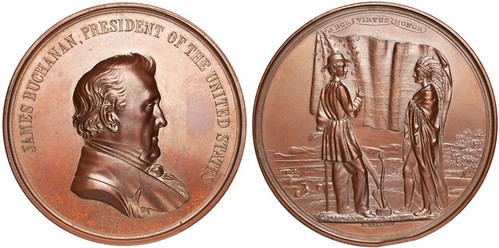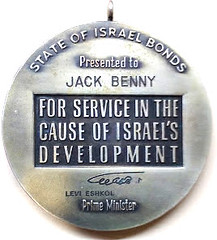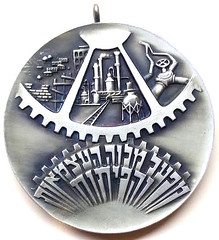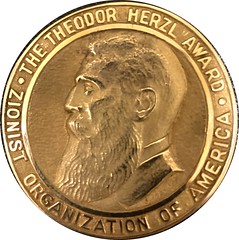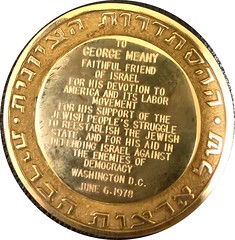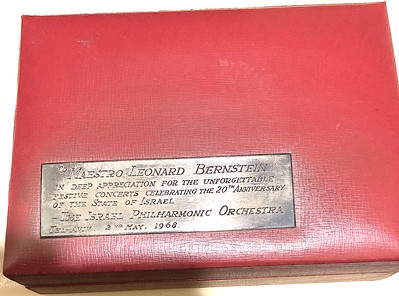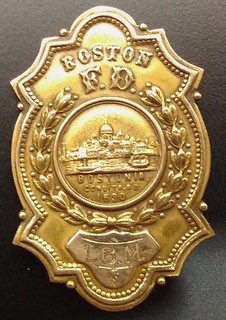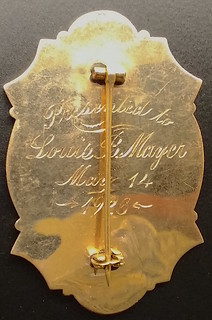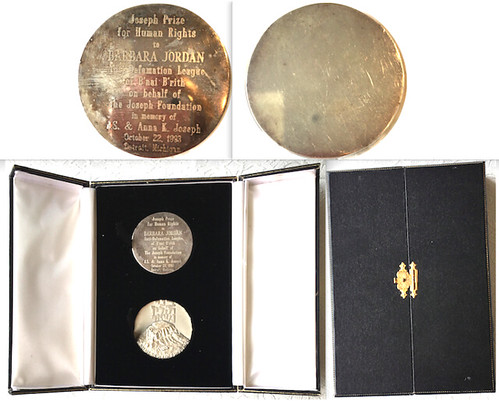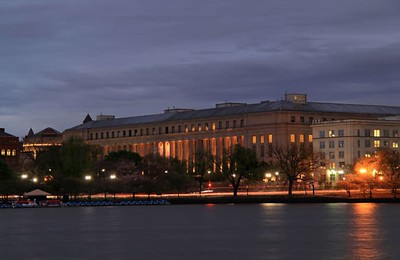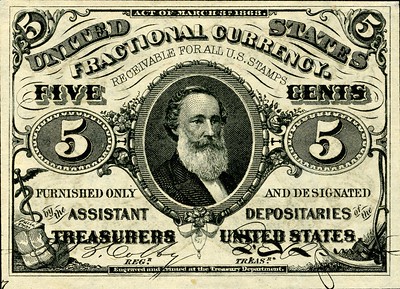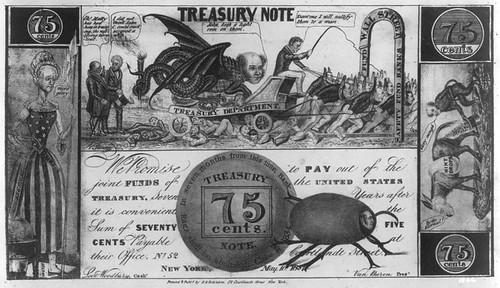
Visit our NBS Sponsors



About UsThe Numismatic Bibliomania Society is a non-profit association devoted to the study and enjoyment of numismatic literature. For more information please see our web site at coinbooks.org SubscriptionsThose wishing to become new E-Sylum subscribers (or wishing to Unsubscribe) can go to the following web page link MembershipThere is a membership application available on the web site Membership Application To join, print the application and return it with your check to the address printed on the application. Print/Digital membership is $40 to addresses in the U.S., and $60 elsewhere. A digital-only membership is available for $25. For those without web access, write to: Charles Heck, Treasurer AsylumFor Asylum mailing address changes and other membership questions, contact Chuck at this email address: treasurer@coinbooks.org SubmissionsTo submit items for publication in The E-Sylum, write to the Editor at this address: whomren@gmail.com BUY THE BOOK BEFORE THE COIN |
- WAYNE'S WORDS: THE E-SYLUM MAY 8, 2022
- NEW BOOK: CAPPED BUST HALF DOLLAR DIE STATES
- NEW BOOK: SOUTH KOREAN COINS
- NEW BOOK: PLANTS IN MODERN NUMISMATICS
- BANKNOTE BOOK ROLLS OUT ACCESS TO CHECKLISTS
- TWIN BOOK AWARDS FOR AUTHOR RUSTY GOE
- APRIL 2022 NNP SYMPOSIUM VIDEOS POSTED
- VIDEO: JOHN FEIGENBAUM INTERVIEW
- SPRING 2022 TORONTO COIN EXPO REPORT
- PAN CIVIL WAR SHOWCASE UPDATE
- CONTINENTAL DOLLAR RESTRIKE DIE SELLS BIG!
- NOTES FROM E-SYLUM READERS: MAY 8, 2022
- JILL MAGID'S TENDER PRESENCE FILM
- COIN COLLECTING BUSINESS ON SOCIAL MEDIA
- VOCABULARY TERM: INSCRIPTION
- ROBERT BASHLOW, PART TWO
- NEW NLG EXECUTIVE DIRECTOR PATRICK IAN PEREZ
- UPCOMING NUMISMATIC EVENTS: MAY 8, 2022
- HEIDELBERGER MÜNZHANDLUNG AUCTION 84
- STEPHEN ALBUM RARE COINS AUCTION 43
- MORE EARLY AMERICAN MAY 2022 HIGHLIGHTS
- CNG FEATURE AUCTION 120 HIGHLIGHTS
- CNG ISLAMIC SALE I HIGHLIGHTS
- DAVISSON'S ANNOUNCES E-AUCTION 43
- NUMISMATIC NUGGETS: MAY 8, 2022
- ROMAN COINS FOUND IN SWITZERLAND
- VALE OF PEWSEY HOARD OF ROMAN SILVER COINS
- MEDIEVAL BRACTEATE HOARD IN POLAND
- 1792 DISME OFFERED
- COMMEMORATIVE MARKET RISE AND FALL, PART 1
- JACOB HOUCK'S COUNTERSTAMP
- ODE TO A SQUISHED DIME
- ANS INDIAN PEACE MEDAL COLLECTION
- JEWISH PRESENTATION MEDALS
- LOOSE CHANGE: MAY 8, 2022
Click here to read the thin version on the web
Click here to subscribe
Click here to access the complete archive
To comment or submit articles, reply to whomren@gmail.com
Content presented in The E-Sylum is not necessarily researched or independently fact-checked, and views expressed do not necessarily represent those of the Numismatic Bibliomania Society.
WAYNE'S WORDS: THE E-SYLUM MAY 8, 2022
 New subscribers this week include:
Daniel Vaisrub, courtesy Laurence Edwards.
New subscribers this week include:
Daniel Vaisrub, courtesy Laurence Edwards.
I have no idea of how many subscribers we have right now, but it's over 6,250. Our email hosting provider has changed hands and we're being moved to new servers. As part of the transition hundreds of email addresses were unsubscribed, and we don't yet know why. Some were dead email addresses, but others were active. I resubscribed one reader, but it may take a while to sort everything out. If you or a friend have been unsubscribed by mistake, please let me know and I'll fix it.
As always, thank you for reading The E-Sylum. If you enjoy it, please send me the email addresses of friends you think may enjoy it as well and I'll send them a subscription. Contact me at whomren@gmail.com anytime regarding your subscription, or questions, comments or suggestions about our content.
So did everyone notice this in the Heritage May 3, 2022 Coin News?
Important: All auctions until further notice will be online only. Take advantage of our high resolution images and videos to place bids up until the live event, and then continue to bid during the Heritage Live auction event, including live streaming audio and video.
This week we open with three new books, updates from the Newman Numismatic Portal, coin show reports, and more.
Other topics this week include author Rusty Goe, artist Jill Magid, Robert Bashlow, Patrick Ian Perez, a TON of upcoming auction highlights, coin hoards, the 1792 Disme, Indian Peace Medals and Jewish presentation medals.
To learn more about Capped Bust Half Dollar varieties, South Korean coins, Carson City coinage, the Dell Loy Hansen collection, the Toronto Coin Expo, strong prices realized, coins on social media, the Numismatic Literary Guild, the Lusitania medal, the Castorland medal, the Pattern Halfgroat of Charles I, and the poem for a squished dime, read on. Have a great week, everyone!
Wayne Homren
Editor, The E-Sylum
NEW BOOK: CAPPED BUST HALF DOLLAR DIE STATES
The Bust Half Nut Club has published a new book on the die state progressions of Capped Bust Half Dollar die varieties. -Editor
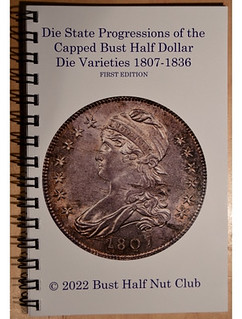 The Bust Half Nut Club is proud to announce a new work on the die state progressions of the Capped Bust Half Dollars.
The Bust Half Nut Club is proud to announce a new work on the die state progressions of the Capped Bust Half Dollars.
The Die State Progressions of the Capped Bust Half Dollar Die Varieties 1807-1836, First Edition is the result of thousands of hours spent studying the series by Overton die marriage. Much additional attention was focused on the order in which the die cracks and other features appear on the obverse and reverse working dies.
For the study of die state progressions, a new numbering system was needed to describe the die states in the order of occurrence. Die states in this new reference are designated by the Year, the Overton variety number, a decimal point, and the BHNC die state number.
The entries are ordered by Overton die variety. Included are the Leaman-Gunnet emission order number, the Overton designators for the obverse and reverse dies, and the die marriage rarity estimate as revised by the BHNC in December 2020. This is followed by the BHNC die state descriptions and links to images which help illustrate the die states. In the PDF format version, the links are active if you also are connected to the internet.
- Printed format (softbound, 5.5" x 8.5", wire binding, 81 pages): $29.00 plus postage
- PDF format (searchable, active links): $20.00 delivered via email
- Both Printed & PDF formats: $39.00 plus postage
For more information, or to order, see:
(Print version) Die State Progressions of Capped Bust Half Dollar Die Varieties, by BHNC
(https://www.davidkahnrarecoins.com/die-state-progressions-of-capped-bust-half-dollar-die-varieties-by-bhnc.html)
(Print & PDF combo) Die State Progressions of Capped Bust Half Dollar Die Varieties, by BHNC (https://www.davidkahnrarecoins.com/print-pdf-combo-die-state-progressions-of-capped-bust-half-dollar-die-varieties-by-bhnc.html)
NEW BOOK: SOUTH KOREAN COINS
Author Mark Lovmo passed along this information about his new book on South Korean coins. Thanks, and congratulations! -Editor
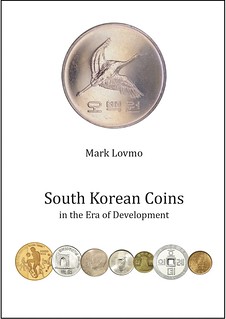 I have finished writing a 400-page book on South Korean coins (1959~present).
I have finished writing a 400-page book on South Korean coins (1959~present).
The book is South Korean Coins in the Era of Development, published by iAsure Group (Journal of East Asian Numismatics). This book is in full color with extensive citations to the source materials.
This book relates for the first time the almost entirely unknown history of Korea's contemporary coins and coin sets that are currently surging in popularity in today's coin market. This book promises to be the first real standard work in English on the subject of South Korean (Republic of Korea) coins.
South Korean Coins in the Era of Development will debut at the World's Fair of Money in Rosemount, Illinois during the week of August 15th through the 20th. Online sales and shipping will be available thereafter. The price per copy is $50 USD.
I am now taking orders for the book. Interested buyers should contact mlovmo@hotmail.com to reserve a copy.
A preview of the book, including its table of contents, is available at http://dokdo-research.com/SouthKoreanCoinBook.html
NEW BOOK: PLANTS IN MODERN NUMISMATICS
Robert Hoge passed along this announcement about a new book in Spanish titled La flora en la Numismática moderna or "Plants in Modern Numismatics". Thank you! -Editor
"Here is another Spanish book presentation announcement -- this time, from the ANE (Asociación Numismática Española, the Spanish Numismatic Association). I gather that the event is to be held at the HQ of the ANE, C/ de la Diputación, 297, (08009) in Barcelona, at 7:00 p.m. on the 19th.
"Dr. Casas Pla is a friend of mine, and I expect to be in attendance. The title of his new book, in translation, would be "Plants (or plant-life -- flora) in modern numismatics" a broad and captivating collectors' theme."
For more information, see:
https://numisane.org/evento/10670/?instance_id=171
BANKNOTE BOOK ROLLS OUT ACCESS TO CHECKLISTS
Last year CDN Publishing acquired the world paper money catalogs edited by Owen Linzmayer and published under the name of The Banknote Book. At the time, I noted how the conversion of the content to a structured database format would lead to many new possibilities.
In this new Greysheet blog article, CDN announces a useful new feature for subscribers. -Editor
 Greysheet and Banknote Book are excited to announce today that we have added the ability for subscribers to download an Excel file of the most current data in the Banknote Book for personal use. According to John Feigenbaum, CDN Publishing CEO, "the Excel checklist has been one the most highly requested features by users of the Banknote Book, and we are really excited to make this feature available to all of our subscribers."
Greysheet and Banknote Book are excited to announce today that we have added the ability for subscribers to download an Excel file of the most current data in the Banknote Book for personal use. According to John Feigenbaum, CDN Publishing CEO, "the Excel checklist has been one the most highly requested features by users of the Banknote Book, and we are really excited to make this feature available to all of our subscribers."
To access the Excel files, users simply need to log in to the site and visit their Banknote Book landing page. From here, click the desired Chapter, and download the file. It's as easy as that.
Feigenbaum adds, "we have many more new features in progress for Banknote Book subscribers. Patrick Ian Perez, Vice President of Data and Content, has been working non-stop on pricing updates. Owen Linzmayer has been busy updating chapters with new entries and our production team is also working to incorporate the latest technology to deliver updated chapters on a nightly basis. This is one of the most exciting projects we've ever attempted and it's all starting to come together."
ABOUT THE BANKNOTE BOOK
Comprised of more than 310 individual chapters (based on country), with a total of 8,200 pages covering more than 77,000 types and varieties, the Banknote Book is the most comprehensive catalog of world paper money in existence.
Users can subscribe to the Banknote Book for as little as $10 per month. The best value can be found by subscribing to the one of our subscription packages.
This is just one of the planned milestones laid out in the firm's product roadmap. Many great possibilities are unlocked by the digital-first strategy, including print-on-demand, completing the circle back to the hardcopy format and country-by-country catalogs enjoyed by so many. -Editor
Once the roadmap is implemented for world paper money, the technical infrastructure could certainly support world coin data as well. I don't know what Krause Publications former owner F+W Media spent its millions on before going bankrupt, but they had little to show for it. "F+W Media's past attempt to build an ecommerce business was cited by current company management as a major mistake." (Publishing Insider, June 19, 2019)
I think CDN Publishing is on a path to succeed where others failed, by using a careful step-by-step approach that sticks to the basics of the numismatic publishing business. We'll look forward to continued product announcements. -Editor
To read the complete article, see:
Banknote Book Subscribers Now Have Access to Checklists in Excel Format
(https://www.greysheet.com/news/story/banknote-book-subscribers-now-have-access-to-checklists-in-excel-format)
To read the earlier E-Sylum articles, see:
F+W MEDIA ASSET SALES APPROVED
(https://www.coinbooks.org/v22/esylum_v22n25a06.html)
CDN PUBLISHING ACQUIRES THE BANKNOTE BOOK
(https://www.coinbooks.org/v24/esylum_v24n22a04.html)
THE BANKNOTE BOOK ROADMAP
(https://www.coinbooks.org/v24/esylum_v24n26a06.html)
TWIN BOOK AWARDS FOR AUTHOR RUSTY GOE
This press release provides some more context on Rusty Goe's recent PNG Book of the Year award. Congratulations! -Editor
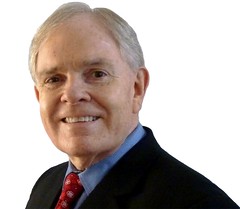 In 2021 the Numismatic Literary Guild (NLG) honored Reno writer/researcher/coin dealer Rusty Goe with double awards for his The Confident Carson City Coin Collector.
In 2021 the Numismatic Literary Guild (NLG) honored Reno writer/researcher/coin dealer Rusty Goe with double awards for his The Confident Carson City Coin Collector.
At the 2022 Central States Numismatic Society convention in Schaumburg, IL, on April 27, the Professional Numismatists Guild (PNG) honored Goe with its prestigious Robert Friedberg Book of the Year award.
In a press release, the PNG stated, "The Robert Friedberg Award, presented to an author in recognition for an outstanding book or other literature, was given to Rusty Goe of Southgate Coins in Reno, Nevada, author of The Confident Carson City Coin Collector. This acclaimed three-volume, 2,500-page reference work is about the historic Nevada branch mint and coins struck there from 1870 to 1893."
This is the second time Goe has won both the NLG's and PNG's Book of the Year awards. In 2004, Goe's The Mint on Carson Street received Book of the Year recognition from both organizations. During the past nearly six decades, only on rare occasions have numismatic authors won both awards for the same book. Walter Breen was so honored in 1988 for his groundbreaking Complete Encyclopedia of U.S. and Colonial Coins. Q. David Bowers, the most distinguished numismatic author of all time, is another who can claim such distinction. Goe's reception of both NLG and PNG honors twice, spanning an 18-year distance in time, speaks highly of the respect his work regarding the Carson City Mint and its coins has earned in the numismatic community.
After more than a year since its sales launch (February 2021), Southgate Coins' co-owner, Marie Goe, says the quantity of sets of The Confident Carson City Coin Collector in stock has diminished significantly. Once the stock is depleted, Southgate Coins will not print any more sets.
For more information, see:
https://www.southgatecoins.com/
To read the earlier E-Sylum articles, see:
NEW BOOK: CONFIDENT CARSON CITY COIN COLLECTOR
(https://www.coinbooks.org/v24/esylum_v24n05a04.html)
BOOK REVIEW: CONFIDENT CARSON CITY COLLECTOR
(https://www.coinbooks.org/v24/esylum_v24n21a06.html)
TOP PNG AWARD NAMED FOR HARVEY G. STACK
(https://www.coinbooks.org/v25/esylum_v25n18a20.html)
APRIL 2022 NNP SYMPOSIUM VIDEOS POSTED
The latest additions to the Newman Numismatic Portal are videos from the recently held NNP Symposium. Project Coordinator Len Augsburger provided the following report. -Editor
Video from the recently held NNP Symposium is now available on Newman Portal. This spring event was held April 8-10 via Zoom, with 24 presentations over a three-day period, focused on U.S. and world numismatics.
Our top three attended sessions included A Behind-the-Scenes Look at the Hansen Collection and a Q&A with John Brush,
Secrets You Should Know About the Rare Coin and Bullion Business,
presented by Michael Garofalo, and Understanding the New Complexities of the Numismatic Auction Market,
presented by Tim Welo. We are grateful to CDN, who offered free books in conjunction with the presentation by Mike Garofalo. Newman Portal thanks all presenters, and we'll be back in the fall with our next event.
Image: Dell Loy Hansen speaks about the formation of his collection.
Link to NNP Symposium video on Newman Portal:
https://nnp.wustl.edu/library/multimediadetail/539070?Year=2022&take=50
VIDEO: JOHN FEIGENBAUM INTERVIEW
These are selections from the David Lisot Video Library that feature news and personalities from the world of coin collecting. David has been attending coin conventions since 1972 and began videotaping in 1985. The Newman Numismatic Portal now lists all David's videos on their website at:
https://nnp.wustl.edu/library/multimediadetail/522852
Here's an interview with John Feigenbaum of CDN Publishing. -Editor
Greysheet Numismatic Publication Optimistic for Coin Market in 2022.
VIDEO: 2.56
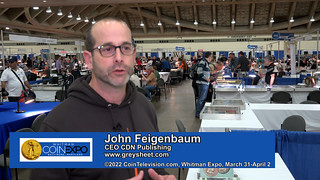 John Feigenbaum, CEO, CDN Publishing,
John Feigenbaum, CEO, CDN Publishing,
David Lisot, Interviewer, CoinTelevision.com.
April 1, 2022.
The Greysheet is part of CDN Publishing that tracks the price of United States coinage. CEO John Feinenbaum prognosticates about the coin market for 2022 in light of the economy, real estate, and the price of the precious metals.
David adds:
"The Greysheet has been the Bible of coin pricing since the 1960's. They have a research team that evaluates trends in collecting. John Feigenbaum shares an outlook for numismatics that might please everyone in the marketplace."
An excerpt of the video is available for viewing on the Coin Television YouTube Channel at:
https://youtu.be/Q_EwmNkFzTs
SPRING 2022 TORONTO COIN EXPO REPORT
Allan Julius Behul submitted this note about the Spring 2022 Toronto Coin Expo and a modern Canadian rarity. Thanks. -Editor
The ‘Back In-Person' Spring 2022 Toronto Coin Expo
Canada's premier coin and bank note show, the ‘Toronto Coin Expo', running from April 29-30, 2022, was back in-person
this year, at the Toronto Reference Library Salon Venue, located in downtown Toronto.
The show featured 35+ internationally-renowned coin and banknote dealers, representing Canadian, United States, and World currencies, including Campbell's Collectables, run by Terry A. Campbell, numismatist and author, with over 56 years of collecting experience.
The event was also host to a live auction, held by Geoffrey Bell Auctions.
Among the plethora of magnificent pieces up for bid in Session II, was Lot 1320, a certified 2000P Twenty-Five Cent ‘Community' coin, graded MS-63 by ICCS, which sold for $10,200 CAD (plus applicable taxes).
The unusual issue is considered a modern Canadian rarity; having the capital letter ‘P' (representing a composition mark) on the obverse side of the coin, below the neckline of Her Majesty Queen Elizabeth II, and above the denomination of ‘25 CENTS'. The coins were produced utilizing pure nickel planchets; however, a number of the 25 cent pieces were accidentally stamped using the obverse die, designed for use with plated coins.
The Spring 2022 Toronto Coin Expo had a great turnout, and was a welcome opportunity to mix and mingle with numismatists, non-numismatists, and collectors alike, F2F (Face to Face), for the first time, in quite a while.
PAN CIVIL WAR SHOWCASE UPDATE
Here's more information on the Civil War Money & Memorabilia Showcase at the upcoming Pennsylvania Association of Numismatists (PAN) show in Monroeville, PA, a Pittsburgh suburb. -Editor
Monroeville PA, May 19, 20 & 21, 2022
Background and Connections:
Many people know General William T. Sherman (also known as Uncle Billy
) for his March to the Sea
towards the end of the Civil War, but few know that he was a gold speculator and a banker before the War broke out. Fewer still know that Sherman's finance career included dealings with the San Francisco Mint in the 1850s. He also dealt with the private assayers in California who produced the phenomenal gold ingots that were routinely shipped east on paddle-wheelers such as the S.S. Central America.
To tell that tale - of how Sherman's pre-War life was impacted by the Gold Rush and the sinking of the so-called Ship of Gold
– the Civil War Showcase is proud to host a special program exploring Sherman's early life in finance with a program based on the new publication:
Uncle Billy was a Banker: How William Sherman's Life was impacted by
California Gold and the S.S. Central America
Two key figures will be featured in this Program: General William T. Sherman (as portrayed by Kris Gunvalsen) and Bob Evans, the principal researcher and curator of the Garden of Gold
that was recovered from the SS Central America deep in the Atlantic Ocean. The discussion will be moderated by Rick Lank, author of Uncle Billy was a Banker.
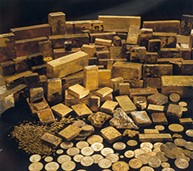 At left is a photo of some of the gold double-eagle coins and
the massive array of gold ingots from California that went
down off the North Carolina coast with the S.S. Central
America in September 1857. Intended as a reserve for Wall
Street Banks (which were already shaky), this loss –
amounting to more than
At left is a photo of some of the gold double-eagle coins and
the massive array of gold ingots from California that went
down off the North Carolina coast with the S.S. Central
America in September 1857. Intended as a reserve for Wall
Street Banks (which were already shaky), this loss –
amounting to more than 1,600 Thousands
of dollars, in
Sherman's own words – created the Panic of 1857
and
resulted in Sherman losing his second banking job in just
two years. (The equivalent dollar amount today would be
in the neighborhood of $50 million.) Sherman also had the
chance to meet the captain of the Bark from Scandinavia that saved 60 lives from the Central
America, shortly after the disaster.
Meet General William T. Sherman (also known as Uncle Billy
)
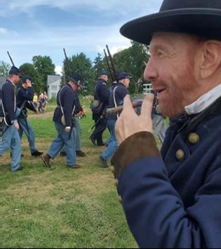 At right is the living history characterization of
General William T. Sherman, as portrayed by Kris
Gunvalsen of Ohio. As a youthful Army man in
California, Sherman was in the very midst of the
California Gold Rush and was posted in the tiny
settlement that became the city of San Francisco
nearly overnight once
At right is the living history characterization of
General William T. Sherman, as portrayed by Kris
Gunvalsen of Ohio. As a youthful Army man in
California, Sherman was in the very midst of the
California Gold Rush and was posted in the tiny
settlement that became the city of San Francisco
nearly overnight once placer gold
was discovered
in the Sierra Nevada mountains. As a banker in San
Francisco, Sherman once carried $40,000 in gold
double-eagles from the newly opened Branch Mint in
saddle bags through the town to keep his bank
afloat – by calling in loans during 1855.
While in California, Sherman also had regular business dealings with the private assayers – such as Kellogg & Humbert - who produced the huge and varied gold ingots for the USA.
Meet Bob Evans, Chief Scientist and Curator
of the S.S. Central America – Pivotal to the
Recovery of The Garden of Gold
 Bob Evans was there on the spot where the
Bob Evans was there on the spot where the Ship of Gold
sank off of the Carolina coast – as a matter of fact, he had
pinpointed the location where the doomed ship went
down. Back in Sherman's time, it was generally believed
that this ship sank fairly close to Savannah, GA. Instead, it
was finally found under 7,200 feet of water a couple of
hundred miles off the coast of North Carolina 40+ years
ago. Bob Evans was an integral part of that astounding
discovery, recovery and interpretation.
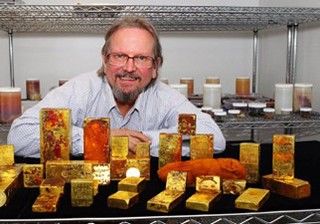 At left, Bob Evans smiles over a portion
of the gold recovered from the SS
Central America in his coin curation lab.
In September of 2021, Bob (along with
Dwight Manley, Managing Partner of
the California Gold Marketing Group)
unveiled the last major
At left, Bob Evans smiles over a portion
of the gold recovered from the SS
Central America in his coin curation lab.
In September of 2021, Bob (along with
Dwight Manley, Managing Partner of
the California Gold Marketing Group)
unveiled the last major stash
from
the ship – a fragile wooden box with
some $3,000 worth of San Francisco-
minted double-eagles… some in
astonishing condition (MS-67).
Other non-numismatic treasures have also been recovered, including the ship's bell.
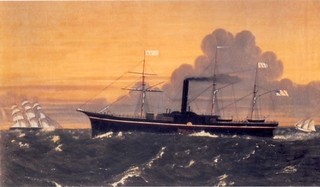 At right is an artist's depiction of the
S.S. Central America at sea. On her last
journey, she sailed from Panama to
Havana, Cuba and then proceeded
towards New York City. She sank in
heavy weather 200 miles off the coast
of North Carolina; at least 425 people
lost their lives in this maritime disaster.
At right is an artist's depiction of the
S.S. Central America at sea. On her last
journey, she sailed from Panama to
Havana, Cuba and then proceeded
towards New York City. She sank in
heavy weather 200 miles off the coast
of North Carolina; at least 425 people
lost their lives in this maritime disaster.
Special One-Hour Program announced for 1pm Saturday the 21st at the Civil War Showcase, PAN Coin Show
Author and Program Organizer Rick Lank will be joining Bob Evans and Uncle Billy
Sherman for a lively three-way discussion at the Civil War Showcase at 1pm on Saturday at the PAN Coin Show, located in the Monroeville Convention Center. Admission to the Coin Show and the Civil War Showcase is free, as well as the Parking. The Showcase's educational non-profit organization– called No Small Change
– welcomes both Sponsors and Contributions.
The Civil War Money & Memorabilia Showcase is launched to honor the 160th Anniversary of the Civil War including how money changed the war…and how the Civil War changed our money, including lasting legacies we see today.
The Inaugural Showcase is produced for educational purposes as a collaboration between No Small Change Programs (Maryland) and PAN
, Pennsylvania Association of Numismatists Foundation (both 501c3 non- profit organizations). The Showcase will include exhibits, talks, and show and tell
-type presentations suitable for all ages. Topics and exhibits include minting, printing and counterfeiting matters of the Civil War.
For more information on the show, see:
https://pancoins.org/
To read the earlier E-Sylum articles, see:
WOMEN'S RELIEF CORPS AT CIVIL WAR SHOWCASE
(https://www.coinbooks.org/v25/esylum_v25n15a17.html)
PAN CIVIL WAR MONEY & MEMORABILIA SHOWCASE
(https://www.coinbooks.org/v25/esylum_v25n17a16.html)
CONTINENTAL DOLLAR RESTRIKE DIE SELLS BIG!
Yowza! That Bashlow Continental Dollar Restrike Reverse Die sold for $102,000.00! Lots of people are scratching their heads over this. -Editor
Tom DeLorey writes:
"... if the sale holds up and the buyer doesn't say something stupid like "But I thought it was an original die from 1776!" or something."
Well, E-Sylum readers certainly knew what it was. And I noticed that "so-called-dollars" is part of the URL for the lot, although not mentioned in the text. It was certainly described as a restrike die. -Editor
So-Called Dollar specialist Jeff Shevlin writes:
"Sometimes there is a logical explanation as to why something like this Dickeson/Bashlow die would sell for so much money, sometimes there is not.
"There have been quite a few fascinating articles of late regarding the original Continental Currency medal, its authenticity and origin of manufacture. That has created more awareness and a newfound interest in Dickeson's medals and the Continental Dollar medal he struck around 1861 (not 1876 as previously believed). The cover article of The Numismatist The Other Continental Dollar published October 2021, authored by Bill Hyder and myself, corrected many long-repeated fallacies regarding the Dickeson Continental Dollar (which is not a restrike). The Bashlow die that recently sold is tied into all of these stories.
"In the next few months, I plan to share with the numismatic community some more fascinating information regarding the Dickeson Continental Dollar. I also look forward to hearing more from David McCarthy regarding his on-going research on the original Continental Dollar. "
To read the complete lot description, see:
Undated Continental Dollar Restrike Reverse Die Uncertified. . From The Fred Weinberg Collection....
(https://coins.ha.com/itm/so-called-dollars/tokens-and-medals/undated-continental-dollar-restrike-reverse-die-uncertified-from-the-fred-weinberg-collection/a/63183-91246.s)
To read the earlier E-Sylum articles, see:
THE FRED WEINBERG COIN DIE COLLECTION
(https://www.coinbooks.org/v25/esylum_v25n16a16.html)
NOTES FROM E-SYLUM READERS: APRIL 24, 2022 : On That Continental Dollar Reverse Die
(https://www.coinbooks.org/v25/esylum_v25n17a12.html)
NOTES FROM E-SYLUM READERS: APRIL 24, 2022 : Robert Bashlow and the Continental Dollar Die
(https://www.coinbooks.org/v25/esylum_v25n17a12.html)
NOTES FROM E-SYLUM READERS: MAY 8, 2022
Surprising Prices Realized
Dave Hirt writes:
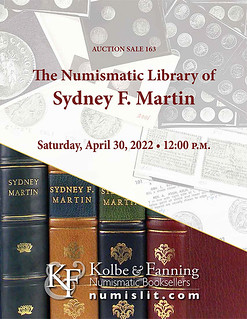 "This week I have been busy writing the prices realized in the Martin sale in my catalog. Even in the inflationary times that
we are living in, the prices on some items were quite a surprise to me! Of course the beautiful bindings of many items
contributed to the prices! One example, lot 266, a bound set of Lester Merkin catalogs, not rare and obtainable, realized
$4750.
"This week I have been busy writing the prices realized in the Martin sale in my catalog. Even in the inflationary times that
we are living in, the prices on some items were quite a surprise to me! Of course the beautiful bindings of many items
contributed to the prices! One example, lot 266, a bound set of Lester Merkin catalogs, not rare and obtainable, realized
$4750.
"However, other lots without deluxe bindings brought high prices. One lot that caught my eye was lot 208, a European catalog, a Adolph Hess sale, the Ulex collection, lot 208 which realized $450. I looked up my copy in my computer inventory, and saw that I had estimated its value at $30. That made me smile!! "
A few of the prices made me smile, too. I've never invested in fine bindings myself, but have acquired a couple over the years. And while many common items bring much less than they often did several years ago, many scarce and rare pieces have continued to climb and are reaching new heights in today's market. -Editor
To read the earlier E-Sylum article, see:
KOLBE & FANNING SYD MARTIN LIBRARY RESULTS
(https://www.coinbooks.org/v25/esylum_v25n18a02.html)
David Tripp's Illegal Tender
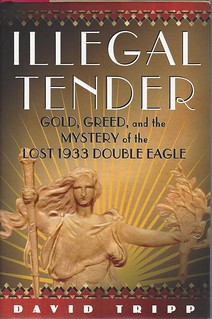 Franklin L. Noel writes:
Franklin L. Noel writes:
"Regarding Ed Kelliher's inquiry about books on individual coins, in addition to Alison Frankel's book about the legendary 1933 Double Eagle, recommended by Joel, there is also David Tripp's Illegal Tender, which covers the same topic."
Correct. Thank you. -Editor
To read the earlier E-Sylum article, see:
QUERY: LEGENDARY COINS
(https://www.coinbooks.org/v25/esylum_v25n18a11.html)
Coins in Movies: Mojave
Regarding coins in movies,
Brad Karoleff writes:
"Do you have Mojave
on the list?
There's a closeup of an 1893 Double Eagle."
No, we didn't have that one! I checked our E-Sylum archive as well as Brian Healy's BrianRxm Website. Thanks. -Editor
To read the earlier E-Sylum article, see:
FEATURED WEB SITE: BRIANRXM
(https://www.coinbooks.org/v20/esylum_v20n43a23.html)
An Alexandrian Hemidrachm
As an addendum to my last Nummis Nova numismatic diary,
Robert Hoppensteadt submitted images of a coin he brought to our April meeting. He writes:
"The Pharos was still standing there in the harbor when ancient Alexandrians were spending this rare hemidrachm on who knows what. This one has weathered the years better than most survivors. RPC IV.4 15820.5 (this coin)"
Thanks! Nice coin. -Editor
To read the earlier E-Sylum article, see:
WAYNE'S NUMISMATIC DIARY: MAY 1, 2022
(https://www.coinbooks.org/v25/esylum_v25n18a26.html)
Query: Delaware Quarter Proposed Design
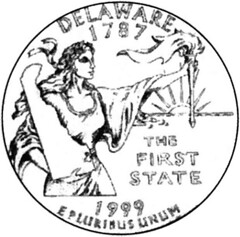 Wayne Pearson writes:
Wayne Pearson writes:
"Does anyone know who the submitter of this Delaware quarter design is?"
Good question. Quarterdesigns.com is not the official U.S. Mint website, but I'm not sure if they publish this information. -Editor
I like this one. Using a state outline is often trite and a waste of space, but having the figure cradle the state in her arm makes for a pleasing and balanced design. I think it's better than the chosen design of an equestrian Caesar Rodney. -Editor
To read the complete webpage, see:
Delaware Proposed Designs
(http://www.quarterdesigns.com/proposed/delaware.html)
1979 Anthony Dollar Error
O. T. Thompson writes:
"Just curious - how many United States coins do readers know of that have been made with Planchet, Die AND Striking errors? Two errors on one coin are fairly common on lower denominations BUT I've not seen ANY with all three (PDS) errors on dollar coins other than the one pictured below.
"This is one I pulled out of a new Mint bag (With gloves.) of Susan B Anthony dollars in 1979. It STILL remains untouched by human hands. Surely, it's a one-in-a-million coin or rarer! By the way, the bag also held another fragment similar to this one!
"The doubling shows up best under the 'WE' on the obverse and part of Anthony's head on the reverse."
Great error! What do readers think? -Editor
THE BOOK BAZARRE
JILL MAGID'S TENDER PRESENCE FILM
Pablo Hoffman and Len Augsburger passed along this NPR story about artist Jill Magid's film on her project to inscribe a pandemic message on the edges of 120,000 cents. See the earlier E-Sylum article for more on the project. -Editor
When artist Jill Magid was asked to do a public art work for the non-profit Creative Time in 2020, she had to take a step back.
"It's very hard to make a public art piece when there's no public and there's a pandemic," she said.
But then she read a New Yorker article, where the co-chief investment officer at the bond fund PIMCO, Mohamed El-Erian, said this about the pandemic economy:
"This is much bigger than 2008. 2008 was a massive heart attack that happened suddenly to the financial markets. You could identify the problem and apply emergency remedies and revive the patient quickly. This is not just a financial stop. This is infection all over the body, damage to virtually every limb and organ. The body was already so fragile. Those of us who have had the privilege of studying failed states have seen this before, but never in a big country like the United States, let alone a global economy."
The body was already so fragile. Those were the words that stuck in Magid's head.
Her project, called Tender, took shape. She had 120,000 pennies inscribed with that phrase, and distributed them through New York City's bodegas, locally-owned convenience stories which were considered essential businesses when the city was shut down in the early stages of the pandemic. She also made a short film with a provocative set of images, juxtaposing Brink's trucks filled with pennies with rows of refrigerated trucks filled with bodies. It's saying the economy is sick; our bodies are sick, too.
Many of the film's close-ups are of hands as the coins pass from clerk to customer. It is both frightening and intimate, reminding us that pennies circulate through our economy like the virus circulates - through contact.
This weekend is the second - and final - time audiences can view the film. It's showing at Dime Savings Bank in Williamsburg, Brooklyn, a neo-Classical building that was once a cathedral of capitalism and is now all peeling paint and hollow, echoing spaces. At set times, eight musicians play the score to the otherwise mostly-silent film, their droning music recalling both the horror of that time and the meditative quality of religion, of reflection. It was important to Magid that there be a place, a time, for people to reflect on all that's happened over the past two years, especially in the place that was originally the virus's epicenter.
Has anyone spotted one of the coins in circulation yet? Have any found their way to a museum collection? -Editor
To read the complete article, see:
She inscribed 120,000 NYC pennies with a pandemic message. Is one in your pocket?
(https://www.npr.org/2022/05/05/1096310474/120k-of-these-pennies-are-in-circulation-do-you-have-one-in-your-pocket)
To read the earlier E-Sylum articles, see:
TENDER: AN EDGE-LETTERED CENT ART PROJECT
(https://www.coinbooks.org/v23/esylum_v23n40a24.html)
NOTES FROM E-SYLUM READERS: OCTOBER 25, 2020 : More on Tender, the Edge-Lettered Cent Art Project
(https://www.coinbooks.org/v23/esylum_v23n43a12.html)
COIN COLLECTING BUSINESS ON SOCIAL MEDIA
It's always nice to see the mainstream media taking notice of numismatics. On Monday May 2, 2022 the Marketplace Morning Report aired as part of National Public Radio's Morning Edition turned a spotlight on the coin collecting business on social media. -Editor
At a recent meeting of the Palm Beach Coin Club, members bought and sold coins, discussed the current market, latest trends and upcoming shows. Matthew Tavory remembered meetings in middle school.
I got $50 from my parents. They let me loose in this room when they had the big shows. And they figured, ‘OK, I was going to come back with some magic beans and it'll be the last they ever hear of this.' I came back with some coins and $100,
he said.
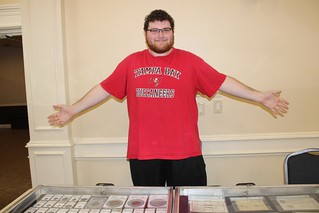 These days, he said he's putting himself through graduate school with his rare coin business.
These days, he said he's putting himself through graduate school with his rare coin business.
Tavory's been selling coins on Instagram since high school. In an interview from his home office in Lake Worth, Florida, Tavory pointed to the pandemic as just one reason his business has boomed. Partially due to the pandemic. Inflation's happening. People are rushing to put their cash into assets that they think will appreciate in value, like gold and silver and collectible coins,
he said.
Tavory specializes in world coins. I have an example here, a coin made during the siege of Vienna when the Ottomans were attacking it in 1529. You don't have that kind of amazing history with U.S. coins.
During the Renaissance, coin collecting became known as the hobby of kings — only the very wealthy could afford it. Now, selling coins is big business on social media and younger collectors are helping to drive the spike in popularity. The pandemic is one explanation for the recent coin boom.
The American Numismatic Association said it's seeing more interest from children and young adults. And apps like Instagram, eBay and Facebook have made collecting easier.
The segment included a short interview with Jeff Garrett as well. -Editor
Young people are really really good at using the tools that the internet provides,
said Jeff Garrett, senior editor of A Guide Book of United States Coins,
known as the Redbook, which is published annually. It took a lifetime to achieve the knowledge that I've accumulated. Now, I'm competing with guys that have been around for a few years but they can look up with a click on their phone most of the things that I've had, took me a lifetime to figure out.
Garrett said online sales at his galleries have doubled since the beginning of the pandemic. This year, he said, he increased the value of nearly every U.S. coin in his book by between 10% and 30%.
To read the complete article, see:
Coin collecting is big business on social media
(https://www.marketplace.org/2022/05/02/coin-collecting-is-big-business-on-social-media/)
To read the earlier E-Sylum article, see:
COIN DEALER MATTHEW TAVORY
(https://www.coinbooks.org/v25/esylum_v25n14a30.html)
VOCABULARY TERM: INSCRIPTION
Here's another entry from Dick Johnson's Encyclopedia of Coin and Medal Terminology. -Editor
Inscription. The lettering on a coin or medal usually appearing horizontally across the field, or upon a figure or device, but in the broadest sense lettering in any position on a numismatic item. It differs from legend which is lettering following the circular contour of the round coin or medal; and exergue, the lettering in this area below the base line. Also vertical inscription exists – lettering which appears vertical to the base line – (or even a wavy inscription with an undulating base line). The study of inscriptions on numismatic items is a branch of epigraphy; the lettering on coins and medals is of vital importance, just as is lettering on monuments, temples and buildings is valuable documentation to historians.
Inscription Content. Inscriptions are dramatically related to the space available in a coin or medal's design. They are abbreviated, or shortened, to fit a tight space –as for most coins – or occasionally expanded for larger medals (words added or lettering made larger). Inscriptions often contain numbers, as dates (either Arabic or Roman), a monarch's number (most often Arabic). Dates of coronation, inauguration, founding dates, or completion date of some public project, all are found as inscriptions. (See dates and dating.)
Often the text of an inscription is composed of mottos, or quotes, as from the Bible, Shakespeare, or prominent authors or poets. (Parts of poems are sometimes inscriptions, in fact the German language has a word for a rhyming inscription on a coin or medal, seligkeitsthaler.)
Inscription characteristics. For the most part inscriptions identify the person or event portrayed in the design and reinforces this by title, date or both. Inscriptions are not captions, like the description of the picture portrayed, but rather they are an integral part of the total design. Inscriptions reveal in words the essence or concept of the piece, what the device reveals in design.
The lettering of inscriptions on coins and medals is almost always in caps, from the tradition of Greek and Roman inscriptions. The shape or typeface of the lettering is, or should be, in harmony with the style of the device. See lettering.
For nearly 2,000 years lettering was formed on coins and medals – at least those that are struck – by punches. A die would be engraved with the device and the lettering would be punched in afterwards to complete the die. See punches, puncheons. (Since 1900 most dies are made from patterns in which both device and lettering, all raised and sunken relief are in the pattern and replicated into the die.)
Varieties in inscriptions. More variations are found in lettering than in devices and other pictorial elements in coin and medal designs. Separate letters, particularly with punches, present more opportunity for an errant letter to be used. Errors of spelling are called blundered inscriptions. These are often corrected causing two die varieties of the piece.
Dates in inscriptions are sometimes corrected – or updated – and titles are infrequently changed for the monarch or person portrayed. In numismatics, examination of inscriptions is very important for identifying varieties.
Cataloging inscriptions. Every letter, punctuation and stop (typographical ornament) should be recorded when cataloging inscriptions. Record exactly every letter and digit; if the numismatic item bears IIII do not record IV. Follow foreign language exactly. Identify any errors in either spelling or letter defects, as upside down punch, for example. (Broken serifs on punches are even cataloged but only for identifying minor die varieties.)
A most important rule: Identify the language of the inscription and translate it into the language of the main text. Inscriptions sometimes appear on coats of arms, shields, or other objects in the design. These should be identified in the description (but are usually not indexed).
Indexing inscriptions. When indexing inscriptions, alphabetize by first words; omit the articles "a" and "the" at the beginning only (record all letters but include all articles afterwards); disregard spaces between words and all numbers (both Arabic and Roman). Indexing by computer will include the spaces, so some adjustment may be necessary after the computer sorts inscriptions alphabetically.
Foreign language inscriptions are indexed exactly as they appear on the numismatic item. Long inscriptions (as a typographic reverse) may be indexed by first words but may be shortened to the first line or two (then adding an ellipse, "..."). This eliminates the need to record the entire lengthy inscription in the index.
Some European numismatic catalogs index all the cataloged items by their inscriptions – so important is it considered in European numismatic and medallic art. For some reason such an index seems less important to Americans.
References:
NE42 {1982} Doty, p 125 (epigraphy), 178-179 (inscription).
NC8 {1988} Breen, p 5-7 (Colonial inscriptions).
N19 {1993} Mackay, p 51-77.
To read the complete entry on the Newman Numismatic Portal, see:
Inscription
(https://nnp.wustl.edu/library/dictionarydetail/516150)
ROBERT BASHLOW, PART TWO
American Numismatic Biographies author Pete Smith submitted the second of his articles on Robert Bashlow, known in numismatics for, among other things, creating satirical medals and restrikes of the Confederate cent. Thanks! -Editor
When Robert Bashlow was born, his parents lived in West Patterson, New Jersey. He was probably born there on June 21, 1939.
He began collecting coins at age ten. At age fifteen in 1954, Bashlow placed an ad in Numismatic Scrapbook Magazine. In the Trades and Exchanges section he offered to trade his Hudson half dollar for a Hawaii half dollar.
Robert Bashlow was not yet twenty when he joined the ANA in May of 1959 as member 33362. In May of 1961, he sponsored David Laties as a new member. Bashlow and Laties were partners in various enterprises. Bashlow converted to life member 429 in January of 1962. Then he was expelled from the ANA in July of 1962 with no stated explanation.
In 1959 he placed an ad in Numismatic Scrapbook Magazine looking to buy 1955 double die cents. Bowers reported in Rare Coin Review 102, …in his day thought this was the neatest thing since sliced bread and borrowed money from a pawnbroker to buy as many as he could…
He promoted the coin and made the market as prices rose. His business model was to acquire coins in quantities that could be promoted through frequent ads in coin publications.
The British farthing was demonetized in 1960 and Bashlow went to England to buy huge quantities for resale and promotional hype in the United States. He also bought a large quantity of British Conder Tokens from Seaby. These were offered with frequent ads in Coin World and Numismatic Scrapbook Magazine. Some were offered through Great Britain Coin Co, a subsidiary of Moore Bashlow Co. [Who was Moore?] In 1963 he offered British pennies in large lots through Coin World ads for Trans-Africa Development Company.
Bashlow created a satirical token in 1961. The obverse legend was CATHOLIC STATES OF AMERICA / IN THE / POPE / WE HOPE / 1963
and reverse GOOD FOR 1 CONFESSION / BY THE / AUTHORITY OF / PRES. KENNEDY / AND / JOHN XXIII.
The 42mm medal was struck in gold, silver and bronze by John Pinches Ltd. Co. in London. Bashlow was concerned that our Catholic president would be unduly influenced by the Pope.
Bashlow and Laties acquired dies from John J. Ford via Q. David Bowers, and started issuing a series of restrikes. Bashlow used transfer dies, made by August Frank and Company in Philadelphia, to strike 30,000 copies of the Confederate cent in various metals. These second restrikes
were heavily promoted in Coin World.
In 1961, Bashlow restruck 7200 copies of the Continental Dollar for the Empire Coin Co. He used transfer dies to strike a commemorative item for the 1964 Boy Scout Jamboree.
Later in 1962 Bashlow created a fantasy restrike using a Henry Hudson Dollar obverse and Bermuda Shilling Reverse.
In 1962, he arranged with Kirkwood in Edinburgh to strike impressions from an 1814 dime die and a God Preserve Philadelphia
reverse. When he returned from Scotland, he was arrested on February 4 and charged with bringing likenesses of U. S. coins into the country from England. He was fined $100. The die was destroyed in the belief that it was counterfeit and the struck impressions were destroyed. A few pieces may have survived in Scotland.
Bashlow also produced other copies from his supply of dies. Production of restrikes was controversial and not welcomed in some parts of the numismatic community. After 1963 his Coin World ads abruptly stopped when the publisher banned him from future advertising. Ads for Great Britain Coin Co. continued into 1965.
Bashlow then went dark after 1965 with no more ads and promotions. It was reported that he was evicted from his apartment for failing to pay his rent and fighting with his landlord. This was not the first time he defaulted on his financial obligations. August Frank and Company took his dies for failure to pay his bills with them.
By 1972, Bashlow was doing business with David Laties and the White Oak Trading Company. The sale of bulk lots of world coins continued. In 1982, after the death of Bashlow, Laties formed the Educational Coin Company which remains in business.
When I previously wrote the biography of Bashlow, I reported that he was affiliated with Williams Trading Company. However, Williams did not appear in Newman Numismatic Portal articles until 1980, after Bashlow was dead.
Next week, the story of Bashlow and Walter Breen.
To read the earlier E-Sylum article, see:
ROBERT BASHLOW, PART ONE
(https://www.coinbooks.org/v25/esylum_v25n18a15.html)
NEW NLG EXECUTIVE DIRECTOR PATRICK IAN PEREZ
The Numismatic Literary Guild has a new Executive Director. Here's the press release. -Editor
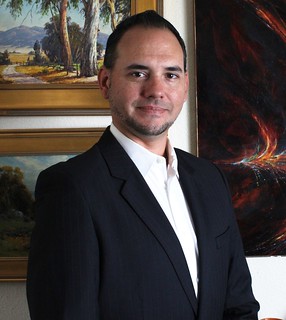 The executive board of the Numismatic Literary Guild (www.NLGonline.org) has appointed Patrick Ian Perez as Executive Director of the organization. He succeeds Charles Morgan, who has served in the position since April 2021.
The executive board of the Numismatic Literary Guild (www.NLGonline.org) has appointed Patrick Ian Perez as Executive Director of the organization. He succeeds Charles Morgan, who has served in the position since April 2021.
A professional numismatist since 2008, Perez is the Vice President of Content and Development for CDN Publishing, publishers of Monthly Greysheet, CAC Rare Coin Market Review, Greensheet, and other numismatic reference guides.
I am excited to take on this opportunity and am optimistic about the future of the NLG,
said Perez. Numismatic writing and research are very important to the industry, and I look forward to collaborating with as many people as possible to advance the NLG mission.
Outgoing Executive Director Morgan, editor-in-chief of CoinWeek, said, "Patrick takes the position at an important time for the organization. As the hobby continues to evolve in surprising ways, it is important to have innovative leaders. Patrick has the full confidence of me and the board. We know that he will continue to move the NLG forward."
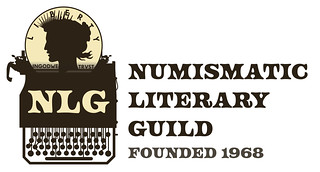 The NLG has begun accepting entries for its annual awards competition that is open to any paid-up NLG as of May 1, 2022. The deadline for submitting entries to Awards Coordinator David W. Lange is June 4. Awards categories, rules, and entry submission information can be found online at
www.NLGonline.org/news/2022-numismatic-literary-guild-awards-competition.
The NLG has begun accepting entries for its annual awards competition that is open to any paid-up NLG as of May 1, 2022. The deadline for submitting entries to Awards Coordinator David W. Lange is June 4. Awards categories, rules, and entry submission information can be found online at
www.NLGonline.org/news/2022-numismatic-literary-guild-awards-competition.
The NLG Board of Directors members are Bob Fritsch, Ron Guth, Dr. Ursula Kampmann, Michael Shutterly, Mel Wacks, and Doug Winter. Maurice Rosen serves as Treasurer and Walter Ostromecki as Secretary.
The Numismatic Literary Guild is a nonprofit organization open to all full-time or part-time editors, authors, writers, bloggers, and content producers who cover news and feature stories about all forms of money, medals, and tokens as collectibles. For information about becoming an NLG member, visit www.NLGonline.org/membership/.
For more information on the Numismatic Literary Guild, see:
https://www.nlgonline.org/
UPCOMING NUMISMATIC EVENTS: MAY 8, 2022
Here are announcements of some current and upcoming numismatic events around the world.
- The Many Lives of the Lusitania Medal is a podcast from a Massachusetts Historical Society seminar, passed along by Robert Hoge
- British Numismatic Society YouTube Channel
- Recognizing Filipino Veterans of World War II, a lecture by Dennis Tucker at the Georgia Institute of Technology in Atlanta
- La flora en la Numismática moderna or "Plants in Modern Numismatics", a new book presentation at ANE (Asociación Numismática Española, the Spanish Numismatic Association)
-Editor
The Many Lives of the Lusitania Medal
For more information, see:
EPISODE 9: THE MANY LIVES OF THE LUSITANIA MEDAL
(https://www.masshist.org/podcast/episode-9-many-lives-lusitania-medal)
British Numismatic Society YouTube Channel
Andrew Pollock writes:
"The BNS has had a YouTube channel for three+ years, but only recently has been posting serious videos."
For more information, see:
British Numismatic Society
(https://www.youtube.com/channel/UCNEJ3RTBMGa2G1q1NgSNL7Q)
Recognizing Filipino Veterans of WWII
Writer and numismatic historian Dennis Tucker will present Recognizing Filipino Veterans of World War II
at 10:00 a.m., Saturday, May 14, 2022, at the Georgia Institute of Technology in Atlanta.
The presentation is part of Cultivating Kapwa,
a free day-long summit organized by the Greater Atlanta chapter of the Filipino American National Historical Society.
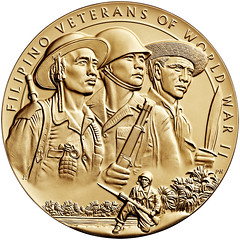 Tucker will discuss the Filipino Veterans of World War II Congressional Gold Medal, which was collectively awarded in October 2017 to Filipinos who served in active-duty military status between July 1941 and December 1946. Honored were those under the command of the United States Army Forces in the Far East (USAFFE) within the Philippine Commonwealth Army, the Philippine Scouts, the Philippine Constabulary, recognized guerrilla units, the New Philippine Scouts, the First Filipino Infantry Regiment, the Second Filipino Infantry Battalion (Separate), or the First Reconnaissance Battalion, including those commanding or serving as U.S. military officers or enlisted soldiers.
Tucker will discuss the Filipino Veterans of World War II Congressional Gold Medal, which was collectively awarded in October 2017 to Filipinos who served in active-duty military status between July 1941 and December 1946. Honored were those under the command of the United States Army Forces in the Far East (USAFFE) within the Philippine Commonwealth Army, the Philippine Scouts, the Philippine Constabulary, recognized guerrilla units, the New Philippine Scouts, the First Filipino Infantry Regiment, the Second Filipino Infantry Battalion (Separate), or the First Reconnaissance Battalion, including those commanding or serving as U.S. military officers or enlisted soldiers.
For more information, see:
Dennis Tucker: Presenting the Filipino Veterans of World War II Congressional Gold Medal
(https://news.coinupdate.com/dennis-tucker-presenting-the-filipino-veterans-of-world-war-ii-congressional-gold-medal/)
Plants in Modern Numismatics
For more information, see:
https://numisane.org/evento/10670/?instance_id=171
HEIDELBERGER MÜNZHANDLUNG AUCTION 84
Here's the press release for the Heidelberger Münzhandlung auction 84, taking place May 9-11. Some beautiful coins here! -Editor
Special Collection Franconian Circle at Heidelberger Münzhandlung
Heidelberger Münzhandlung presents rare German coins of excellent quality and, in addition, an extensive offer of world coins from antiquity to modern times. Besides remarkable individual lots, connoisseurs will find a special collection with specimens from the Franconian Circle of the Holy Roman Empire.
From 9 to 11 May 2022, Heidelberger Münzhandlung will hold its auction 84. The material is divided into two catalogues. The first one contains 429 lots with coins and medals from the Franconian Circle of the Holy Roman Empire. The second catalogue is filled with world coins from antiquity to present times. As always, there is an extensive offer of coins from the German states and German issues after 1871, but collectors of coins from the Holy Roman Empire will also find many rarities. Particularly impressive is the selection of German multiple gold coins of magnificent quality.
Attention! Once again, the auction will be held as a live bidding event at the premises of Heidelberger Münzhandlung. Bidders may only participate via email, phone or online.
No. 143 – Eichstätt. Sede vacante. Konventionstaler 1781, Nuremberg. Extremely fine. Estimate: 1,500 euros.
An Interesting Local Collection from the Area of the Franconian Circle
To simplify administrative matters, the Holy Roman Empire of the German Nation was
divided into circles, which grouped imperial cities, imperial knights, ecclesiastical and secular
principalities into geographical units. The Franconian Circle was one of the most prestigious
ones, which is why it was listed as circle number 1 in the course of the imperial reform of 2
July 1500.
The collector focused his purchases to members of the Franconian Circle, but he did not slavishly adhere to its boundaries. And that is precisely why this collection provides an excellent overview of the coin and medal production at the heart of Germany.
No. 174 – Henneberg. Taler 1698, yield from the mines of Ilmenau. Rare. Extremely fine. Estimate: 2,000 euros.
Issues from the following regions are on offer: Bamberg, Bavaria (issues related to Franconia), Brandenburg-Franconia, Brandenburg-Ansbach, Brandenburg-Bayreuth, the Teutonic Order starting with the election of Maximilian as Deutschmeister in 1590, Eichstätt, Erbach, Fulda, Henneberg, ...
No. 201 – Hohenlohe-Kirchberg. Karl August, 1737-1767. Taler 1737, Nuremberg, commemorating the death of his father Friedrich Eberhard. About FDC. Estimate: 3,000 euros.
... Hohenlohe with its various lines, Kronach, Leuchtenberg, Löwenstein, Mainz, Nuremberg, Öttingen, Rieneck, Rothenburg ob der Tauber, Saxe-Coburg and other Saxon lines ...
No. 316 – Schwarzenberg. Johann Adolph, 1641-1683. Taler 1682, Vienna. Extremely rare. Extremely fine. Estimate: 5,000 euros.
... Schwarzenberg, Schweinfurt, Weißenburg, Windsheim, Würzburg as well as joint issues of the Franconian Circle and literature on the subject. On the same day, general numismatic literature from the second part of auction 84 will be on sale.
No. 543 – Maximianus Herculius. Gold quinarius. Depeyrot 417 (only 1 specimen in the possession of a museum). Mint state. Estimate: 20,000 euros.
Ancient and World Coins
On the morning of 10 May, the second part of auction 84 will start with ancient coins. As
always, the offer includes some rarities of splendid quality. These include three Celtic quarter
starters from the Middle Rhine and two octodrachms of Ptolemy IV. Moreover, collectors will
find a gold quinarius (!) of Maximianus Herculius – an extremely rare specimen of mint state
quality. Depeyrot only knows of one other specimen in the possession of a museum.
No. 549 – Artabasdus, 742-743. Solidus. Extremely rare. Very fine. Estimate: 20,000 euros.
At least as rare is a solidus of the Byzantine usurper Artabasdus. In his German standard work
on Byzantine coinage, Andreas Sommer writes: Artabasdus' coins are among the rarest
issues in the entire history of Byzantine coinage.
This is due to the fact that the Armenian
general, who ascended the throne as a figurehead of those who were in favour of images, was
defeated by Constantine V after only a few months.
No. 677 – Romania. Carol II, 1930-1940. 100 lei 1939, Bucharest, commemorating the 100th birthday of Charles I. Extremely rare. Extremely fine. Estimate: 125,000 euros.
In all likelihood, a gold 100 lei piece of 1939, minted by Carol II of Romania in this crucial year of his reign, must be described as an unpublished and unique specimen. The impressive denomination must probably be understood against the background of the personality cult of Carol II. Every year, Carol had himself celebrated by his people on 10 May and 8 June. He presented himself as the Conducator (= leader) sent by God, whose purpose in life was to create a new Romania.
No. 950 – Augsburg. 6 ducats 1763, commemorating the Treaty of Hubertusburg. Extremely fine. Estimate: 35,000 euros.
Coins from the German States
If you know Heidelberger Münzhandlung, you know that especially collectors of coins from
the German States will find a wealth of interesting objects. In addition to interesting talers of
exceptional quality, this auction also offers many multiple gold coins, such as this splendid
1763 Nuremberg issue that was minted to commemorate the Treaty of Hubertusburg.
No. 1067– Bavaria. Gold medal of 12 ducats, 1842, commemorating the wedding of Max II Joseph and Marie of Prussia. Extremely rare. Extremely fine. Estimate: 20,000 euros.
Of interest for collectors of Bavarian and Prussian coins is a gold medal of 12 ducats issued in 1842 on the occasion of the wedding of Max II Joseph, heir to the throne, and the Prussian Princess Marie Friederike. By the way, this unconventional queen was the first female mountaineer of the Bavarian royal house.
No. 1120 – Brunswick-Wolfenbüttel. Rudolph August, 1666-1685. Löser of 4 talers with value mark, 1679, Zellerfeld. From the Friedrich Wielandt Collection. Very rare. Extremely fine. Estimate: 20,000 euros.
A 1679 löser of the Brunswick Duke Rudolph August comes from the collection of the well- known numismatist Prof Dr Friedrich Wielandt (1906-1996). However, the great scholar was rather known for other research focuses. The former head of the Baden Coin Cabinet was obviously of utmost importance for Baden numismatics. Moreover, he wrote numerous standard works on the coinage of various Swiss cantons which are still used as references today.
No. 1336 – Münster. Christoph Bernhard von Galen, 1650-1678. 6 ducats 1661, commemorating the caption of the city. From the Friedrich Wielandt Collection. Very rare. Extremely fine. Estimate: 20,000 euros.
Another piece from the Wielandt Collection is a magnificent 6 ducat coin from 1661 that was minted to commemorate the capture of the city of Münster by its Prince-Bishop Bernhard von Galen. The variety of this weight, by the way, is extremely rare. The coin features a detailed city view of Münster with all fortifications and the towers of the major churches.
No. 1268 – Kempten. Half taler 1623. Very rare. Extremely fine to mint state. Estimate: 6,000 euros.
This 1623 half taler of the imperial city of Kempten is an example for the splendid quality that connoisseurs can find in Heidelberger Münzhandlung's catalogue. The very rare specimen is extremely fine to mint state.
No. 1388 – Prussia. Frederick II, 1740-1786. Taler 1781, Breslau. Hoym taler
,
commemorating the 42th birthday of minister Karl Georg Heinrich von Hoym. Extremely
rare. About extremely fine. Estimate: 35,000 euros.
Another specimen of outstanding quality is the so-called Hoym taler
featuring the portrait
of Frederick the Great. The piece, which was minted in Breslau and gives the date of the 42th
birthday of Karl Georg Heinrich von Hoym – the minister ruling in Silesia – was reprimanded
by the king. The Berlin government forced the Breslau mint master to withdraw all coins of
this issue, which is why the Hoym taler is now one of the great rarities of Prussian
numismatics.
No. 1660 – German Empire. 1 mark 1881 G. Extremely rare in this quality. FDC. Estimate: 9,000 euros.
German Coins After 1871
Customers of Heidelberg Münzhandlung are already used to it: Herbert Grün's catalogue
offers an extensive selection of coins from the German Empire. Although the estimates of
individual, extremely rare pieces – such as this FDC 1 mark piece of 1881 from the Karlsruhe
mint – are in the upper four-digit range, this area still offers many highly interesting coins of
splendid quality for rather modest prices. The estimates of fractional coins from the German
Empire start in the lower two-digit range!
No. 1740 – German Empire. Baden. 5 marks 1876. Extremely rare in this quality. Specimen from the Paproth Collection! First strike in proof quality. Estimate: 12,000 euros.
Of course, Heidelberger Münzhandlung also offers great rarities – and presents specimens of a quality that leave nothing to be desired. A great example is this 5 marks piece from Baden of 1876 that also has an exquisite provenance: it is from the Paproth Collection.
No. 2307 – German Empire. Saxe-Meiningen. 20 marks 1914. Very rare, only 1001 specimens minted. Extremely fine +. Estimate: 16,000 euros.
Of course, there is a comprehensive selection for collectors of coins from the German Empire too. As an example, we show you a 20 marks piece of 1914 from Saxe-Meiningen. A coin type of which only 1001 specimens were minted and a high number was probably melted down again.
No. 2618 – Postage Stamp Token of the Carl Squires company with a stamp of 10 pfennigs
numeral
. Extremely fine. Estimate: 50 euros.
The auction closes with a collection of postage stamp tokens – a category between numismatics and philately. It is emergency money that uses a stamp as a substitute for small change. To protect the stamp, it was enclosed in a capsule that was often adorned with advertising slogans of the issuing institution. In other words: these items are virtually the descendants of English tokens.
The auction catalogue of Heidelberger Münzhandlung can be purchased for the nominal fee of 12.50 euros at Heidelberger Münzhandlung Herbert Grün, Gaisbergstr. 40, 69115 Heidelberg, Germany; phone: +49 / 6221 / 65 2970; fax: +49 / 6221 / 65 297-29; email: kontakt@hdmhg.de. Of course, the catalogue is also available online: on Sixbid, biddr.com and Numisbids.
For more information, see:
https://hdmhg.de/
STEPHEN ALBUM RARE COINS AUCTION 43
Here's the press release for Stephen Album Rare Coins upcoming Auction 43. Some great coins! -Editor
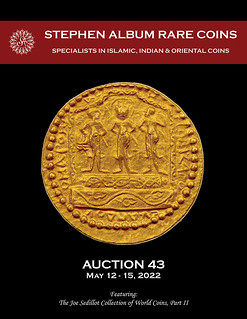 Stephen Album Rare Coins will hold its Auction 43 on May 12-15, 2022 at its offices in Santa
Rosa, California. The Auction is made up of 3,250 lots of Ancient, Islamic, Chinese, Indian, and
General World Coins. The pre-sale estimate is approximately $1.5 million USD, with the final
total expected to far exceed that amount.
Stephen Album Rare Coins will hold its Auction 43 on May 12-15, 2022 at its offices in Santa
Rosa, California. The Auction is made up of 3,250 lots of Ancient, Islamic, Chinese, Indian, and
General World Coins. The pre-sale estimate is approximately $1.5 million USD, with the final
total expected to far exceed that amount.
Featured in the sale is the Joe Sedillot Collection of World Coins (Part II) which includes a wide array of type coins from numerous countries. A large proportion of the coins in the collection are in choice condition and were selected for encapsulation in PCGS holders. Part I was offered in the firm's January 2022 sale and many pieces went for multiple times estimate and some items set new price records. Additional selections from the collection will be offered in subsequent auctions in the second half of 2022.
One notable change the firm has made beginning with their January 2022 auction is that the group/bulk lots are now consolidated at the end of the sale for more convenient locating (see lots 2713 to 3250).
Some highlights from the sale follow:
LOT 28 – EGYPT: PTOLEMAIC KINGDOM: Ptolemy VI Philometor, 181/0-145 BC, AV octodrachm-mnaieion (27.60g), Kition (Citium), Cyprus, year 29 (153/2 BC), Svoronos— (unrecorded date), SNG Copenhagen—, struck in the name of the deified Queen Arsinoe II (died 270 BC), head right with ram's horn, veiled and wearing stephanos, lotus-tipped scepter in background // double cornucopiae bound with fillet, pomegranates and grape clusters hanging from the brim of each horn, date (LKT) and mintmark (KI) on either side, APSINOHS FI?A?E?FOY, light scratches in obverse field, bent and brushed, Strike 5/5, Surface 2/5, NGC graded Choice EF, possibly unique. Estimated at $20,000 to $25,000 USD
LOT 186 – GEORGIA: UMAYYAD CALIPHATE: 'Abd al-Malik, 685-705, AR dirham (2.76g), Tiflis, AH85, A-126, Klat-197, Bennett-54, some modest damage near the edge, but all inscriptions are fully legible and the weight is correct for a similarly worn early Umayyad dirham, VF, RRRR. Tiflis is one of the extremely rare Umayyad dirham mints, and is one of the most popular, the first Islamic coin struck in Georgia and in great demand amongst Georgian collectors. There are no examples of this mint on CoinArchives (except the unique piece dated AH86). Estimated at $14,000 to $16,000 USD
LOT 715 – CHINA: FUKIEN: Republic, AR 20 cents, year 21 (1932), Y-391, L&M-854, WS-1066, Canton Martyrs Commemorative issue with Yellow Flower Mound Mausoleum (Huanghuagang), double die reverse, a fantastic toned example and rarely so nice! PCGS graded MS66, ex Joe Sedillot Collection. This is by far the finest graded example by PCGS or NGC as both have graded only a single coin in MS-64 and none higher. Estimated at $3,000 to $5,000
LOT 838 – INDIA: KUSHAN: Huvishka, ca. 155-187 AD, AV dinar (7.96g), G-157.1, BMC- XXVIII/24, NC-XX/17 (same reverse die), ANS Kushan—, diademed and crowned half-length bust
left, with flames above right shoulder, holding mace and ankusa (elephant goad), clouds below, ÞAOhAHOÞAO O-OhÞKI KOÞANO // three nimbate figures standing facing on double dais within ornate aedicule, the central figure crowned, the others with their heads turned toward him, tamgha in inner left field, MA-AC-H-NO BIZAGO CKAN?O K-OMAPO, Choice AU, RRR, This is the first example of this type to be offered for sale in a public auction. Estimated at $50,000 to $55,000 USD
LOT 878 – INDIA: COOCH BEHAR: Nripendra Narayan, 1838-1911, AV nazarana mohur, CB354 (1864), KM-180, sri sri / siva char(ana) / kamala mad / huka(asya) in Bengali; pellet within crescent after legend; all within linear quadrate border with floral ornaments at corners; additional floral ornaments in external voids; all within border of alternating dentils and pellets // sri sri / nripendra / nara / yana / san 354 sake in Bengali; floral ornaments flanking sri sri, a lovely toned lustrous nearly mint state example! PCGS graded AU58, RRR. Estimated at $10,000 to $15,000
LOT 1476 - ZANZIBAR: Sultan Ali Bin Hamud, 1902-1911, AE cent, 1908, KM-83, ruler's name and titles in ornate Arabic calligraphy // Palm tree; dragon-headed sea monsters entwined at base, denominations in Arabic and Gujarati, a very rare one-year type, a beautifully toned mint state example! PCGS graded MS64 BN, RR, ex Joe Sedillot Collection. According to James Sweeny, none of the bronze decimal series of 1908 were released to circulation. Remick has stated that no more than 20 to 60 pieces of each type exist, with other sources reporting only 20-30 pieces of this type surviving. This example is tied for finest graded by PCGS! Estimated at $3,000 to $4,000 USD
SARC Chief Operations Officer Mike Barry commented: The Joe Sedillot Collection attracted
many bidders to our January auction. We expect the same excitement from bidders for the lots
featured in the May auction. This sale is likely to be one of our best yet with high quality items
from across all categories. We have been making an effort to build sales that have quality coins
that appeal to collectors of all levels. Whether you are looking to spend a few hundred dollars
or a much larger sum there is something here for everyone.
The firm is now taking consignments for future premier and online auctions.
More information can be found on their website at www.stevealbum.com
MORE EARLY AMERICAN MAY 2022 HIGHLIGHTS
Here's a selection of colonial coin and medal highlights in the May 14, 2022 Early American History Auctions sale. -Editor
(c. 1694) London Elephant Halfpenny Token, with Diagonals at center of Reverse Shield, Betts 81, Hodder 1-A, Whitman 12000, Very Choice, PCGS graded About Uncirculated-55.
From an old-time collection, put away for decades this coin is superb for the grade. It has full strong details, gorgeous chocolate brown surfaces, and the glossy luster loved by copper collectors. Among U.S. Colonial coins, the elephant token is one of the most unusual and popular. The presence of the reverse side diagonals makes this a particularly rare variety, one that is ranked Rarity-6 by experts, and one which is considerably more rare than the usually-seen variety without the diagonals. Seldom are the Diagonals variety found this nice. In fact, this is the second finest example certified by PCGS out of the ten examples listed in their Population Report. To the best of our knowledge, the finest example is a PCGS MS-62BN, followed by an NGC MS-61BN, an NGC AU-58, then this PCGS AU-55 in fourth place for both services. Adding to its desirability, this coin is fresh to the market, having been purchased privately by our consignor in 1980. This is a tremendous opportunity for a Colonial specialist to add a Condition Census-level rarity to their collection.
To read the complete lot description, see:
https://www.earlyamerican.com/Auctions/ClientPages/lots.item.php?auction=5&lot=281
1785 Immune Columbia Pattern, Nova Constellatio, Pointed Rays, Extra Star in Legend, Breen 1117, Whitman 1960, Rarity 6+, PCGS graded XF-45.
Rarity 6+ (about 12 believed to exist). 145.6 grains. A choice example with light brown surfaces, nicely struck up details and normal, light circulation. This Rare 1785 Immune Columbia Pattern coin combines the only known Immune Columbia obverse with a reverse later used on the Crosby 2-B variety of the 1783 Nova Constellatios. A mere dozen examples are believed to exist. PCGS has graded only seven examples of this rarity and we suspect this includes some duplication. This type rarely appears at auction. Since 1980, there have been only 13 auction appearances of this type, but that number is misleading because four of those appearances are of the same coin, resulting in only nine discreet examples. The finest of the lot was Donald Partrick's Mint State example that sold for $82,250 in 2015, indicating the desirableness and popularity of this variety. This coin has been off the market for decades and did not appear in any of the above-mentioned auction citations. Because of its rarity, choice quality and freshness to the market, we expect active and strong bidding for this lot.
To read the complete lot description, see:
https://www.earlyamerican.com/Auctions/ClientPages/lots.item.php?auction=5&lot=284
1787 New York Excelsior Copper, Indian and Eagle on Globe Type, Breen 991, Whitman 5800, Rarity-7, PCGS graded Fine-15.
The 1787 New York Excelsior Copper, Indian and Eagle on Globe is one of the great rarities in the U.S. Colonial series. This example offers a nice, two-tone appearance with tan high points and slightly darker surfaces. Though this example spent some time in circulation, the wear is even and moderate, with no unexpected marks or defects. The centering is good, though the obverse drifts slightly towards 5 o'clock on the obverse and towards 2:00 on the reverse. The date is completely on the flan, though the 1 and the first 7 touch the rim. Condition on these is secondary to their rarity. This coin is a new addition to the Condition Census, having been off the market for the past three or four decades. This example would probably rank as the 9th finest overall, making it one of the more affordable and attainable of this major type. We would not be surprised to see our high estimate exceeded. Again, condition is moot, as any collector of U.S. Colonial coins would be thrilled to own this attractive coin.
To read the complete lot description, see:
https://www.earlyamerican.com/Auctions/ClientPages/lots.item.php?auction=5&lot=285
1786 Vermont Copper. Landscape Type. VERMONTENSIUM Legend. Ryder-7. Bressett 5-E. Whitman W-2025. PCGS graded About Uncirculated-50.
117.9 grains. Whitman Rarity URS-8 (65 to 124 known). This choice, very impressive Vermont Landscape Copper is full weight, sharply struck with just some typical reverse die weakness as made. The planchet is hard and glossy with excellent overall eye appeal. Only a couple of planchet flaws in the obverse surface are as shown. Its rims are sharp and the natural surfaces hard and smooth. The Green Mountains, Rising Sun and Pine Trees designs are distinct. Struck off-center on both sides, shifting the obverse design toward 1:00 and the reverse design toward 5:00. This puts the all-important date and lower denticles fully on the planchet. A lovely Condition Census AU-50 of this VERMONTENSIUM Landscape Type.
To read the complete lot description, see:
https://www.earlyamerican.com/Auctions/ClientPages/lots.item.php?auction=5&lot=291
1796 Castorland Medal, Original dies, Struck in Silver, Superb Natural Toning, PCGS graded MS-62 (our grade MS-63 Prooflike or Proof).
An early strike from the Original dies, with minimal rust at the pot handle and with no trace of a die crack at S or PARENS. Exceptionally beautiful coloration shimmers from the deep mirror surfaces and help to further highlight the frosty central devices. One of the most eye appealing examples we have ever seen in well over two decades. Some light hairlines are seen under magnification, but remain otherwise invisible to the naked eye being covered with the fabulous multicolored toning. With lustrous golden-russett to sea greens and blue the natural toning on this coin is outstanding and is most enjoyable to behold in person. We feel that this coin is quite conservatively graded and likely deserves an added couple of points for the great eye appeal. We note a major auction house sold an NGC AU-58 for $9,000 (hammer) bringing $10,800 in 2020. This current coin should be viewed in its full blazing color on our web site, or seen in person, to attain a full appreciation of its vibrant, Prooflike blazing nature.
To read the complete lot description, see:
https://www.earlyamerican.com/Auctions/ClientPages/lots.item.php?auction=5&lot=296
1779-Dated Rare Revolutionary War Period Large Size 6.5 (165 mm) Decorative Benjamin Franklin Portrait Terra Cotta Plaque Medallion. By Jean-Baptiste Nini. Choice About Uncirculated.
An extremely rare design Benjamin Franklin Portrait medallion of museum quality and great collector desirability. This large sized impressive 6.5 (165 mm) diameter which is much larger than the usual 1777 Nini Medals. This terra cotta Nini
Medal features a plain Bust portrait of Benjamin Franklin facing left. His image is surrounded by the legend: B. FRANKLIN IL DIRIGE LA FOUDRE ET BRAVE LES TIRANS," (He directs lightning and braves tyrants). It was made by Jean-Baptiste Nini (Italian, 1717-1786) and displays true high-relief in detail, with Nini's name incuse on the left side of the bust and a raised crest on the right side. Dated
1779
just below and to the right of the bust. A small tunnel was drilled through the top and back of this medal so that a wire or twine could be passed through for suspension. This is a superb display piece and a wonderful addition to any collection of Franklin memorabilia. This is the first example we've ever offered of this rare design type, which is an important point considering we've offered more than (40) 1770 Nini Medals since 1994.
To read the complete lot description, see:
https://www.earlyamerican.com/Auctions/ClientPages/lots.item.php?auction=5&lot=305
1757 French and Indian War, Philadelphia Treaty of Easton
or Duffield
Indian Peace Medal of George II, Struck in Silver, dies for this medal engraved by Edward Duffield, for the Society of Friends (Quakers) in Philadelphia, Struck in 1757 by Silversmith Joseph Richardson, with its Original Silver Loop / Not holed, Custom holder, Extremely Fine.
Julian IP-49, Jamieson-8, Betts-401, 44 mm. The First Peace Medal Issued in America. An exceptional, eye-catching attractive original silver medal. The dies for this historic early American engraved and struck medal were engraved by Edward Duffield, made for the Society of Friends (Quakers) in Philadelphia. Of these first American medals only 54 were struck in 1757, made by Philadelphia silversmith Joseph Richardson, Sr.. Twelve Silver medals were Awarded
on the occasion of the Signing of the Treaty of Easton
in 1758.
Later, the original dies passed to Joseph Richardson, Jr.. In 1813, Richardson, Jr. wrote to a friend, Thomas Wistar, recounting that his father had struck the Duffield
Medals, and that the dies had remained in the family for many years, but at some time in the early years of the 1800's, the original engraved dies were passed to the United States Mint. In a curious side-note, Edward Duffield was a personal friend of Benjamin Franklin, and Duffield was the executor of Ben Franklin's estate following his death.
All known Originals
were Struck over Mexican Silver 8 Reales (Pillar Dollars
or Pieces of Eight
), thus they all have the ornamented edges leftover from the host coin. Also, Originals have no trace of the horizontal or vertical die cracks mentioned above. The current medal offered here has sharp Extremely Fine details. The surfaces are attractive with significant eye appeal. They are mostly smooth, hard, and reflective, with a few scattered small marks on both sides. There is a rim bruise at 9 o'clock, confirming that this example was issued and worn by an important Native American Indian Chief, thus adding to its historical value. Currently this medal is housed in a custom gold-lettered engraved Capital Plastics holder titled, THE DUFFIELD INDIAN PEACE MEDAL / STRUCK IN 1757 / BETTS 401
.
It's original Silver Suspension Loop is attached, being the Only Silver Medal Known with its Original Loop Intact and has not been holed. An extreme rarity, famous for being the First Peace Medal Issued in America. For many years, only two Originals of this medal were known - the one in Charles Fisher's sale of March 1936, and a lesser grade holed
piece that brought $52,900 in a Bowers and Merena Galleries sale, March 2001, lot 2007. Today, about 13 Original Silver examples are known per a census listed in the John Ford/Boyd Collection Sale catalog of 2006. Four silver medals are known to be impounded in institutional collections. The remaining examples are all held in strong collector hands. In 2009, an unmounted Choice Extremely Fine example sold at auction for $103,500. The finest certified example is an NGC MS-62 Holed
from the Ford/Boyd Collection, which was recently resold in 2021 at auction for $168,000 (Holed at the top for suspension). The currently offered Treaty of Easton
/ Duffield
medal is new to the Census. It has never previously appeared at auction to our best knowledge, making it the 14th Original Silver medal known. It ranks among the finest, especially not holed and unique, with its original silver loop intact.
To read the complete lot description, see:
https://www.earlyamerican.com/Auctions/ClientPages/lots.item.php?auction=5&lot=320
To read the earlier E-Sylum article, see:
EARLY AMERICAN MAY 2022 AUCTION HIGHLIGHTS
(https://www.coinbooks.org/v25/esylum_v25n18a24.html)
CNG FEATURE AUCTION 120 HIGHLIGHTS
Here's the press release for Classical Numismatic Group's Auction 120, closing May 11-12, 2022. -Editor
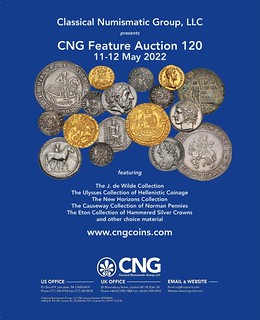 An impressive offering of English hammered silver coins, an array of Greek
masterworks and more than 100 Roman gold pieces are coming to the auction block in Classical Numismatic
Group LLC's Feature Auction 120, closing May 11-12, 2022.
An impressive offering of English hammered silver coins, an array of Greek
masterworks and more than 100 Roman gold pieces are coming to the auction block in Classical Numismatic
Group LLC's Feature Auction 120, closing May 11-12, 2022.
With 1,335 lots at a total pre-sale estimate of $2.4 million, CNG 120 a well-rounded offering that
collectors across the whole spectrum of Ancient, World and English coins will find enticing, said Michael
Gasvoda, CNG's Managing Director. The strong market and our recent spectacular success with Triton XXV in
January brought in a number of outstanding consignments,
he noted. Our bidders will reap the benefits.
The English section features the New Horizons and Causeway Collections, offering a remarkably comprehensive holding of hammered silver of the late Anglo-Saxon, Norman, and early Plantagenet kings. Covering nearly two centuries of English history from Aethelred II to Stephen, this section includes 100 different silver pennies struck at 36 different mints, a veritable tour of early England.
Highlights include:
To read the complete lot description, see:
NORMAN. Henry I. 1100-1135. AR Penny (21mm, 1.42 g, 11h). Large Profile/Cross and Annulets type (BMC viii). Southwark mint; Leofwine, moneyer. Struck circa 1113.
(https://auctions.cngcoins.com/lots/view/4-5IONSK/norman-henry-i-1100-1135-ar-penny-21mm-142-g-11h-large-profilecross-and-annulets-type-bmc-viii-southwark-mint-leofwine-moneyer-struck-circa-1113)
To read the complete lot description, see:
NORMAN. Stephen. 1135-1154. AR Penny (19mm, 1.15 g). Ornamental group, flag type. York mint. Struck circa 1145-1149.
(https://auctions.cngcoins.com/lots/view/4-5IONT8/norman-stephen-1135-1154-ar-penny-19mm-115-g-ornamental-group-flag-type-york-mint-struck-circa-1145-1149)
Also featured in the sale is a fine run of hammered silver crowns from the Eton Collection, including a number of choice pieces struck during the reign of Charles I:
CNG 120's Greek offering comprises 555 coins, including a run of Macedonian silver and gold issues from the Ulysses Collection, coins of Northern and Central Greece from the James Gilman Collection, a diverse group of early electrum coinage, and many important early Judean issues. Greek highlights include:
To read the complete lot description, see:
SICILY, Gela. Circa 490/85-480/75 BC. AR Didrachm (20mm, 8.70 g, 6h).
(https://auctions.cngcoins.com/lots/view/4-5IOLXS/sicily-gela-circa-49085-48075-bc-ar-didrachm-20mm-870-g-6h)
To read the complete lot description, see:
SICILY, Leontini. Circa 430-425 BC. AR Tetradrachm (25mm, 17.28 g, 3h).
(https://auctions.cngcoins.com/lots/view/4-5IOLYE/sicily-leontini-circa-430-425-bc-ar-tetradrachm-25mm-1728-g-3h)
To read the complete lot description, see:
KINGS of MACEDON. Alexander I. 498-454 BC. AR Tristater – Oktadrachm
(32mm, 28.90 g, 8h). Light Aeginetic standard. Aigai mint. Struck circa 476/5-460 BC.
(https://auctions.cngcoins.com/lots/view/4-5IOM3V/kings-of-macedon-alexander-i-498-454-bc-ar-tristater-oktadrachm-32mm-2890-g-8h-light-aeginetic-standard-aigai-mint-struck-circa-4765-460-bc)
To read the complete lot description, see:
KINGS of PONTOS. Mithradates VI Eupator. Circa 120-63 BC. AV Stater (20mm, 8.34 g, 11h). Pergamon mint. Dated month 10, year 213 BE (July 84 BC).
(https://auctions.cngcoins.com/lots/view/4-5IOMC2/kings-of-pontos-mithradates-vi-eupator-circa-120-63-bc-av-stater-20mm-834-g-11h-pergamon-mint-dated-month-10-year-213-be-july-84-bc)
To read the complete lot description, see:
PERSIA, Alexandrine Empire. temp. Stamenes – Seleukos. Satraps of Babylon, circa 328/3-311 BC. AV Double Daric (19mm, 16.90 g). Babylon mint.
(https://auctions.cngcoins.com/lots/view/4-5IOMOE/persia-alexandrine-empire-temp-stamenes-seleukos-satraps-of-babylon-circa-3283-311-bc-av-double-daric-19mm-1690-g-babylon-mint)
Among the Roman coins offered are than 100 Roman gold aurei and solidi, including several extreme rarities. Roman emperors and empresses represented by gold aurei (often by multiple coins) include Claudius, Otho, Vespasian, Titus, Domitian, Domitia, Nerva, Trajan, Hadrian, Aelius Caesar, Antoninus Pius, Faustina Senior, Marcus Aurelius, Faustina Junior, Lucius Verus, Commodus, Caracalla, Julia Domna, Gordian III, Philip I, Herennia Etruscilla, and Hostilian. The sale also includes gold solidi of Constantius II, Julian II, Valens, Theodosius I, Magnus Maximus, Honorius, Theodosius II, Valentinian III, Leo I, Leo II, and Zeno.
Roman Provincial, Republican and Imperial highlights include:
To read the complete lot description, see:
PHRYGIA, Apameia. Macrinus. AD 217-218. Æ Octassarion (36mm, 23.25 g, 5h).
(https://auctions.cngcoins.com/lots/view/4-5IOMVZ/phrygia-apameia-macrinus-ad-217-218-octassarion-36mm-2325-g-5h)
To read the complete lot description, see:
SELEUCIS and PIERIA, Antioch. Mark Antony & Cleopatra VII of Egypt. 36 BC. AR Tetradrachm (27mm, 15.11 g, 12h).
(https://auctions.cngcoins.com/lots/view/4-5IOMXJ/seleucis-and-pieria-antioch-mark-antony-cleopatra-vii-of-egypt-36-bc-ar-tetradrachm-27mm-1511-g-12h)
To read the complete lot description, see:
Gaius (Caligula), with Divus Augustus. AD 37-41. AR Denarius (18mm, 3.65 g, 3h). Lugdunum (Lyon) mint. Last emission, from 1 January AD 41.
(https://auctions.cngcoins.com/lots/view/4-5ION3K/gaius-caligula-with-divus-augustus-ad-37-41-ar-denarius-18mm-365-g-3h-lugdunum-lyon-mint-last-emission-from-1-january-ad-41)
To read the complete lot description, see:
Domitia. Augusta, AD 82-96. AV Aureus (19.5mm, 7.52 g, 6h). Rome mint. Struck under Domitian, AD 88-89.
(https://auctions.cngcoins.com/lots/view/4-5ION6P/domitia-augusta-ad-82-96-av-aureus-195mm-752-g-6h-rome-mint-struck-under-domitian-ad-88-89)
To read the complete lot description, see:
Hadrian, with Divus Trajan. AD 117-138. AV Aureus (20mm, 7.19 g, 6h). Rome mint. Struck August-December AD 117.
(https://auctions.cngcoins.com/lots/view/4-5ION7N/hadrian-with-divus-trajan-ad-117-138-av-aureus-20mm-719-g-6h-rome-mint-struck-august-december-ad-117)
To read the complete lot description, see:
Commodus. AD 177-192. AV Aureus (20mm, 7.72 g, 12h). Rome. Struck AD 192.
(https://auctions.cngcoins.com/lots/view/4-5IONBI/commodus-ad-177-192-av-aureus-20mm-772-g-12h-rome-struck-ad-192)
To read the complete lot description, see:
Constantine I. AD 307/310-337. AR Medallion of 5 Siliquae (28mm, 15.46 g, 6h). Donative to Commemorate the Dedication of Constantinople. Constantinople mint, 5th officina. Struck shortly before 11 May AD 330.
(https://auctions.cngcoins.com/lots/view/4-5IONET/constantine-i-ad-307310-337-ar-medallion-of-5-siliquae-28mm-1546-g-6h-donative-to-commemorate-the-dedication-of-constantinople-constantinople-mint-5th-officina-struck-shortly-before-11-may-ad-330)
Pre-bids on all coins in CNG 120 may be placed via the company's website, www.cngcoins.com. The live auction will commence at 9 am EDT on Wednesday, May 11, continuing through Thursday, May 12, and can be followed via CNG's Auction Mobility platform on the website. To receive a printed copy of the full-color catalog and a detailed schedule, contact Classical Numismatic Group LLC at CNG@cngcoins.com, or call (717) 390-9194.
CNG ISLAMIC SALE I HIGHLIGHTS
Classical Numismatic Group, LLC is holding its first all-Islamic auction later this month. Here's the press release. -Editor
The earliest Islamic silver coin struck bearing an Arabic date, the first gold dinar
issued by the Fatimid dynasty, and an extremely rare Spanish gold dinar of the Wolf King,
Muhammad b.
Sa‘d, are among the highlights of Classical Numismatic Group's first dedicated auction of Islamic coins, to be
held as a live online sale on May 25 in Lancaster, PA.
We are delighted to bring this excellent offering of Islamic coinage to market under the CNG banner,
said Stephen Lloyd, Islamic specialist for Classical Numismatic Group LLC. There are some coins of great rarity
and historic importance presented here, including pieces which any collector of Islamic or world coins would
be proud to own.
CNG Islamic Sale I comprises 224 lots of gold, silver and bronze coinage, with estimates totaling nearly $550,000. Highlights of the sale include:
Lot 24 – An Arab-Sasanian silver drachm dated AH 72 (AD 691/2), the first Islamic silver coin to bear a mint and date written in Arabic.
To read the complete lot description, see:
Umayyad Caliphate. temp. ‘Abd al-Malik ibn Marwan. AH 65-86 / AD 685-705. AR Drachm (32.5mm, 3.38g, 3h). Dimashq mint. Dated AH 72 / AD 691/2.
(https://auctions.cngcoins.com/lots/view/4-5WQUNB/umayyad-caliphate-temp-abd-al-malik-ibn-marwan-ah-65-86-ad-685-705-ar-drachm-325mm-338g-3h-dimashq-mint-dated-ah-72-ad-6912)
Lot 42 – An excessively rare Arab-Sasanian drachm issued by ‘Abdallah b. Bastam, one of the rarest governors named on Arab-Sasanian coins and believed to be one of only two or three examples known.
To read the complete lot description, see:
Umayyad Caliphate. temp. ‘Abd al-Malik ibn Marwan. AH 65-86 / AD 685-705. ‘Abdallah b. Bastam. Circa AH 82 / AD 701/2. AR Drachm (31.9mm, 4.13g, 11h). KRMAN-GRM (Garmshir) mint. Dated AH 82 / AD 701/2.
(https://auctions.cngcoins.com/lots/view/4-5WQUOC/umayyad-caliphate-temp-abd-al-malik-ibn-marwan-ah-65-86-ad-685-705-abdallah-b-bastam-circa-ah-82-ad-7012-ar-drachm-319mm-413g-11h-krman-grm-garmshir-mint-dated-ah-82-ad-7012)
Lot 56 – A lovely Arab-Byzantine gold semissis with two Imperial busts, of interest to Byzantine collectors as well as Islamic specialists.
To read the complete lot description, see:
Umayyad Caliphate. temp. ‘Abd al-Malik ibn Marwan. AH 65-86 / AD 685-705. AV Semissis (11.5mm, 2.02g, 6h). ‘Africa' (Carthage) mint. Undated.
(https://auctions.cngcoins.com/lots/view/4-5WQUP5/umayyad-caliphate-temp-abd-al-malik-ibn-marwan-ah-65-86-ad-685-705-av-semissis-115mm-202g-6h-africa-carthage-mint-undated)
Lot 61 – An Umayyad dinar of AH 77 - the first purely Islamic gold coin, one of the great rarities of the Islamic series.
To read the complete lot description, see:
Umayyad Caliphate. temp. ‘Abd al-Malik ibn Marwan. AH 65-86 / AD 685-705. AV Dinar (20mm, 4.15g, 6h). Without mint-name. Dated AH 77 / AD 696/7.
(https://auctions.cngcoins.com/lots/view/4-5WQUPH/umayyad-caliphate-temp-abd-al-malik-ibn-marwan-ah-65-86-ad-685-705-av-dinar-20mm-415g-6h-without-mint-name-dated-ah-77-ad-6967)
Lot 68 – A very rare early Umayyad gold dinar from the mint of Ifriqiya (Carthage).
To read the complete lot description, see:
Umayyad Caliphate. temp. Yazid II ibn ‘Abd al-Malik. AH 101-105 / AD 720-724. AV Dinar (19.1mm, 4.23g, 3h). Ifriqiya mint. Dated AH 102 / AD 720/1.
(https://auctions.cngcoins.com/lots/view/4-5WQUPX/umayyad-caliphate-temp-yazid-ii-ibn-abd-al-malik-ah-101-105-ad-720-724-av-dinar-191mm-423g-3h-ifriqiya-mint-dated-ah-102-ad-7201)
Lot 145 – An extremely rare Spanish gold dinar struck at Valencia by Muhammad b. Sa‘d, 'The Wolf King'.
To read the complete lot description, see:
Kings of Murcia (post-Almoravid). Muhammad ibn Sa‘d. AH 542-567 / AD 1147-1171. AV Dinar (24.7mm, 3.83g, 1h). Balansiya (Valencia) mint. Dated AH 545 / AD 1150/1.
(https://auctions.cngcoins.com/lots/view/4-5WQUUI/kings-of-murcia-post-almoravid-muhammad-ibn-sad-ah-542-567-ad-1147-1171-av-dinar-247mm-383g-1h-balansiya-valencia-mint-dated-ah-545-ad-11501)
Lot 164 – The first gold dinar issued by the Fatimid Dynasty, dated AH 296 / AD 909/10.
To read the complete lot description, see:
Fatimids. temp. Abu ‘Abd Allah al-Shi'i. AH 296-297 / AD 909-911. AV Dinar (18.6mm, 4.15g, 8h). Al-Qayrawan mint. Dated AH 296 / AD 908/9.
(https://auctions.cngcoins.com/lots/view/4-5WQUVK/fatimids-temp-abu-abd-allah-al-shii-ah-296-297-ad-909-911-av-dinar-186mm-415g-8h-al-qayrawan-mint-dated-ah-296-ad-9089)
Lot 198 – A remarkable Great Seljuk gold dinar with dragons surrounding the legends, a radical departure from the usual purely epigraphic norm.
To read the complete lot description, see:
Great Seljuks. Ghiyath al-Din Muhammad I Tapar. AH 491-511 / AD 1105-1118. EL Dinar (20.7mm, 3.34g, 8h). Harat mint. Dated AH 498 / AD 1104/5.
(https://auctions.cngcoins.com/lots/view/4-5WQUXH/great-seljuks-ghiyath-al-din-muhammad-i-tapar-ah-491-511-ad-1105-1118-el-dinar-207mm-334g-8h-harat-mint-dated-ah-498-ad-11045)
Lot 221 – A handsome gold Nazarana mohur of the Durrani ruler Zaman Shah.
To read the complete lot description, see:
Durrani Shahs. Zaman Shah. AH 1207-1215 / AD 1793-1800. AV Nazarana mohur (28.6mm, 11.05g, 10h). Dar al-Sultanat Kabul. Dated AH 1209 / AD 1794/5. Regnal year 3.
(https://auctions.cngcoins.com/lots/view/4-5WQUYR/durrani-shahs-zaman-shah-ah-1207-1215-ad-1793-1800-av-nazarana-mohur-286mm-1105g-10h-dar-al-sultanat-kabul-dated-ah-1209-ad-17945-regnal-year-3)
Pre-bids on all coins in Islamic Auction I may be placed via the company's website, www.cngcoins.com. The live auction will commence at 10 am on Wednesday, May 25, and can be followed via CNG's Auction Mobility platform on the website.
Inquiries about Islamic Auction I may be sent to Steven Lloyd at stevelloyd@cngcoins.com. To receive a copy of the full-color catalog, contact Classical Numismatic Group LLC at CNG@cngcoins.com, or call (717) 390-9194. Clients in the United Kingdom and Europe may contact CNG's London office at (+44) 20-7495-1888.
DAVISSON'S ANNOUNCES E-AUCTION 43
Davissons Ltd. has announced their E-Auction 43, which closes June 8, 2022. Here's an excerpt from today's email to clients penned by Allan Davisson, which discusses pricing and valuation before providing a short preview of the sale. -Editor
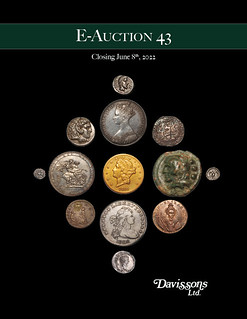 Pricing coins fairly so that the values accurately reflect fair values is an important and demanding part of preparing each catalog. We could open everything at zero, the way most US coins are auctioned. But there are daily price guides for US coins and the great extent to which US coins are graded and slabbed and then awarded a numerical grade also serves as a key factor in setting a price.
Pricing coins fairly so that the values accurately reflect fair values is an important and demanding part of preparing each catalog. We could open everything at zero, the way most US coins are auctioned. But there are daily price guides for US coins and the great extent to which US coins are graded and slabbed and then awarded a numerical grade also serves as a key factor in setting a price.
Most of what we offer is specialized and much of it rather obscure. So we work to provide a defensible valuation that both seller and buyer should find within a range of current market pricing.
It was reading a catalog from a British colleague that led me to think about writing about valuation. That catalog offered a number of lots of modern British gold estimated at current market levels—note the actual prices realized below. But the catalog also published what the consignor paid fairly recently to two English firms outside the established community of British coin dealers. The prices the consignor paid for modern mint issues were remarkable in terms of what they are worth in a market that includes both selling and buying. For example, an Elizabeth II Britannia five ounce gold proof (a bullion issue), estimated at £7-9000 was bought in 2021 for £16,999 (it realized £6800); a five-piece 2021 gold proof set estimated at £2750-£3250 cost the consignor £6,999 (realized £3100); a gold proof £2 2002 estimated at £7-900 cost £2,999 (realized £875). I counted over 70 lots where the collector paid prices at two to three times current market value.
Asking—and getting—higher-than-market prices for coins is not something new. In an auction bidders can sometimes keep competing until remarkable prices result. But marketing coins for prices well outside normal trading levels usually results in disappointment and even serious losses for that buyer when they are presented back to the market through established venues. The firms offering this material make no representation about investment or about buying back except under very limited circumstances. It is a question of creating a mark-up on material to a client base that is unfamiliar with our industry.
There are cases where overpriced coins are fraudulently sold as investments. That is a different story. Minnesota passed a law a few years ago requiring professional coin specialists to have a license and a bond after some convictions for a couple of firms that were pushing overpriced investment grade
coins to uninformed buyers.
Rare coins have always been an investment though not in the sense that stocks, bonds, real estate or even simple bullion are. American collectors do not get capital gains credit when their coins are sold. But increased market activity in numismatics during some economic downswings clearly shows that coins as an investment hedge have an appeal. There are even fractional ownership of extremely rare items now being offered.
This means that we make a concerted effort to determine a fair market value for what we offer. This is important in dealing with sellers as well as buyers. Our goal is to determine a realistic range—a band of value—and then to estimate on the more conservative side of that range.
Our best estimate of a defensible market value reflects years of experience and sales records as well as familiarity with the quirks and idiosyncrasies of the material itself. The valuation also reflects access to internet reports of auction prices, time spent studying auctions and sales lists from other established firms, published price guides based on current research, and often discussion among the three of us about an accurate price point.
This catalog brings a major consignment to an end—the final lots of the Michael Sussman token collection. He assembled a wide-ranging collection of high grade 18th century tokens. It has been a pleasure to offer them. Some smaller collections of choice tokens have helped fill out our sales. Out next catalog will begin offering tokens from a collection formed over many years that emphasized tokens issued for actual trade.
Interesting gold—most estimated at a small advance beyond underlying melt value, Greek silver and bronze including the second installment of the Seleukid coin consignment, attractive and often scarce Roman coins, a British section that begins with British Celtic coins and ends with collections of modern material, the last section of the Scottish collection along with key Scottish references from the same collector, more world material from the collection formed following the mid-18th century US Mint collection, some US material—coins, tokens, currency.
It seems that each time I set about writing an introductory note I see that we have again been able to present a broad ranging mix of eras and individuals and types. History in your hand
is someone else's motto but with each of our catalogs we try to keep that thought in mind.
For more information, see:
https://davcoin.com/
NUMISMATIC NUGGETS: MAY 8, 2022
Here's a selection of interesting or unusual items I came across in the marketplace this week. Tell us what you think of some of these. -Editor
GAUL, Massalia. Circa 150-125 BC. AR Drachm (16mm, 2.68 g, 12h). Light standard. Diademed and draped bust of Artemis right; bow and quiver over shoulder; to right, ?I monogram above K / Lion standing right; to right, ?I monogram above K. F&P DRM-38-7; Depeyrot, Marseille 38/7. A couple of light marks, hairlines and die wear on reverse. Near EF.
Massalia (modern Marseille) was a major trading entrepôt settled by the Greeks on the coast of Southern Gaul in the 6th century BC. Its coinage circulated widely in southern Gaul and Northern Italy. The iconic lion on the reverse refers to the Gulf of Lion. The Massalia drachms offered in the next six lots date from late in the city's independence, before it was absorbed by Rome in 49 BC.
Great looking coin. From the May 25th CNG Islamic I sale. See the article elsewhere in this issue for more information. -Editor
To read the complete lot description, see:
GAUL, Massalia. Circa 150-125 BC. AR Drachm (16mm, 2.68 g, 12h). Light standard.
(https://auctions.cngcoins.com/lots/view/4-5IOLVF/gaul-massalia-circa-150-125-bc-ar-drachm-16mm-268-g-12h-light-standard)
Pattern Halfgroat of Charles I
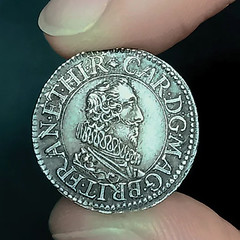 In our upcoming Auction (number 105) we have on offer a Charles I, Pattern Halfgroat issued by Nicholas Briot. Briot's pattern Halfgroats for Charles I seem to either be the portrait type or the 1640 no legend, large crown (North 2688), non-portrait issue.
In our upcoming Auction (number 105) we have on offer a Charles I, Pattern Halfgroat issued by Nicholas Briot. Briot's pattern Halfgroats for Charles I seem to either be the portrait type or the 1640 no legend, large crown (North 2688), non-portrait issue.
Our example is the Silver type [they were also offered in Copper], bare headed bust facing right in an elaborate ruff contained within an inner linear circle, the legend reads CAR DG MAG BRIT FRAN ET HIR, lozenge stop above King's head. These exact coins were fastened to Briot's first coinage between 1631-2 (references: North 2687; Brooker 1255). The reverse displays two crowned interlocking C's which denote the denomination of a two pence or half-groat, a ‘B' signed below for the designer, all contained within a linear circle, beaded borders both sides, the legend reads FIDEI DEFENSOR, which translates to defender of the faith. A fascinating little coin, a classic example of the proficiency and ability of Nicholas Briot, with an excellent provenance trail.
From the Baldwin's blog. -Editor
To read the complete article, see:
THE NICHOLAS BRIOT PATTERN HALFGROAT OF CHARLES I
(https://www.baldwin.co.uk/news/the-nicholas-briot-pattern-halfgroat-of-charles-i/)
Obverse: GIVE THY IUDGEMENTS O GOD UNTO THE KING, bust of James
Reverse: AND THY RIGHTEOUSNESSE UNTO THE KINGS SONNE, bust of prince Charles
By Simon van de Passe
Simon van de Passe (ca. 1595 – May 6 1647), was the eldest son of Dutch publisher and engraver Crispijn van de Passe. He worked in England from about 1616 before moving to Copenhagen as royal engraver and designer of medals in 1624, where he remained until his death. He is best remembered for his early London print of Pocahontas (1616).
Interesting item. Alas, it's already been sold. -Editor
To read the complete lot description, see:
Great Britain. Ca. 1620. Simili engraved token or counter James I and Charles, Prince of Wales, workshop of Simon van de Passe
(https://www.vcoins.com/en/stores/jongeling_numismatics__ancient_art
/280/product/great_britain_ca_1620_simili_
engraved_token_or_counter_james_i_and_charles_prince_of_wales
_workshop_of_simon_van_de_passe/1563433/Default.aspx)
ROMAN COINS FOUND IN SWITZERLAND
Arthur Shippee passed along this story about a Roman coin find in Switzerland. Thanks. -Editor
An amateur Swiss archaeologist discovered a trove of 1,290 Roman coins that date back to the reign of Constantine the Great.
Using a metal detector, Daniel Lüdin found the coins inside a clay pot that was buried underground. Last year in September, he found the pot in a forest near Wildenstein Castle in Bubendorf, Switzerland.
Archäologie Baselland later extracted the find in its entirety. Using computer tomography at the Swiss Federal Laboratories for Materials Testing and Research, experts scanned the 9-inch-tall pot without disturbing the coins, which made it possible to see leather remnants wedged between them.
What purpose the leather served remains a mystery, though it is known that the coins are primarily composed of copper alloy and traces of silver, and are the equivalent of a small bowl of change. Weighing far less than an ounce, they add up to roughly two months' salary for a soldier at that time.
The coins, which date from 332–355 C.E., were minted during a period of peace and prosperity in the Roman Empire under Constantine the Great, who governed from 306-377 C.E. Few coins from that period have ever been discovered.
To read the complete article, see:
A Trove of Ancient Roman Coins Was Uncovered by an Amateur Archaeologist in Switzerland
(https://www.artnews.com/art-news/news/roman-coins-constantine-the-great-uncovered-by-amateur-1234627938/)
VALE OF PEWSEY HOARD OF ROMAN SILVER COINS
This Noonan's press release discusses the Vale of Pewsey hoard of Roman silver coins. -Editor
It was over two days in September 2020, after the first Covid lockdown had finished, that three metal-detectorists with over 90 years detecting experience between them, came across a wonderful hoard of Roman silver coins in an extremely unusual way! The hoard of 142 coins which is expected to sell in the region of £30,000–40,000 will be offered for sale by specialist Coin, Medal, Banknote and Jewellery auctioneers Noonans (previously Dix Noonan Webb) in their frst sale under their shortened name on Tuesday, May 17, 2022 at their Mayfair saleroom (16 Bolton Street, London W1J 8BQ).
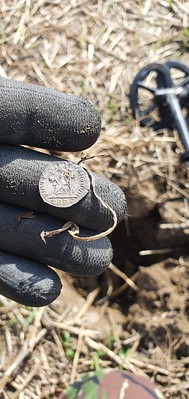 Mick Rae, a 63-year-old herds manager; Robert Abbott (53) who owns a computer shop and Dave Allen (59) a carpenter were spending the weekend camping on a field in Wiltshire. Dave and Rob both live in Essex, and Mick, at the time, lived in Wiltshire.
Mick Rae, a 63-year-old herds manager; Robert Abbott (53) who owns a computer shop and Dave Allen (59) a carpenter were spending the weekend camping on a field in Wiltshire. Dave and Rob both live in Essex, and Mick, at the time, lived in Wiltshire.
As Rob explained: Having fnished breakfast first, I turned on my machine, a Minelab Equinox 800, and having walked around six paces from the tent, I found several tent pegs and just under the surface a late Roman silver siliqua in pristine condition. A few moments later beside it, I found another one!
This prompted both Mick and Dave to grab their detectors and help in the search. Over the course of the weekend they found 161 coins in total, comprising silver siliqua and miliarense dating from AD 340–402. They had to keep them in their camping washing-up bowl as they didn't have anything else to store them in.
Rob continued: Ironically, we had been camping there 2 weeks previous for a week-long detecting outing. What we hadn't realised is we'd actually camped right on top of the area where the coins were found!
He finished: Unbelievably I don't actually have any photographs of myself finding any coins. I think everyone else was too excited to be taking pictures! We are looking forward to the forthcoming auction but at the moment, we have no idea how we will spend the money.
As Nigel Mills, Consultant (Artefacts and Antiquities) at Noonans explains:
Virtually all of the coins are in mint condition and have not
even needed to be cleaned since their discovery. The hoard was
buried at a time when Roman rule in Britain under the Emperor
Honorius was no longer viable with the army being recalled to
protect other provinces. In AD 410 Britain was told to protect
itself by Honorius.
He went on to say: As a result Britain has become a treasure island of late 4th century and early 5th century gold and silver Roman coin and jewellery hoards as the local population buried their valuables and then fell victim to Saxon raids. Detector fnds in recent years include the Thetford and Hoxne hoards.
The British Museum has studied the coins and is retaining just two coins for their collection from the hoard.
For more information, see:
https://www.noonans.co.uk/
MEDIEVAL BRACTEATE HOARD IN POLAND
Leon Saryan passed along this story of a hoard of medieval bracteate coins discovered in Poland. Thanks. -Editor
A hoard of medieval bracteate coins has been discovered near Walbrzych in Lower Silesia, Poland.
The coins were unearthed by a dog walker, who notified authorities at the Walbrzych Branch of the Provincial Office for Monument Protection in Wroclaw.
The coins are one sided and made from thin sheets of metal due to the limited availability of silver or gold. They originate from the mint workshops of Brandenburg, Saxony and Silesia, although their use was relatively short as the coins were usually called back regularly (about once or twice a year) to be exchanged for new coins.
In receiving three new coins for four old coins, the withheld 4th coin was called strike money and was often the only tax revenue of the coin mint-master. This system worked like a demurrage, with people often hoarding their coins because they lost their value.
The coins have been described as one of the most significant discoveries in the region, as very few coins of this type survive from the period as they were melted down on an ongoing basis.
To read the complete article, see:
Bracteate treasure hoard found near Walbrzych
(https://www.heritagedaily.com/2022/04/bracteate-treasure-hoard-found-near-walbrzych/143376)
1792 DISME OFFERED
Stack's Bowers Numismatist Christopher Maisano published a blog article this week about a great coin coming up in the firm's August 2022 sale - a 1792 Disme. Beautiful piece! -Editor
We are pleased to feature a Judd-10 1792 disme that will be a highlight in our August 2022 Global Showcase Auction. The 1792 disme is an important rarity, struck in very small numbers in the earliest days of the United States Mint. Today about 15 copper examples are known to survive in all grades, while only three are known in silver. The disme, no matter its composition, ranks high with the other 1792 issues in terms of historical significance, as it is the denomination that Thomas Jefferson personally suggested as equal to the value of a half pistareen and ensured a decimal base to the newly developed American monetary system.
For collectors whose numismatic interest is tied to history, nothing could top the issues of 1792. They were the very first products of the Mint, part of a start-up that was overseen by Jefferson and President George Washington. The MS-62 (PCGS) disme in our August 2022 auction is the finest known Judd-10 example and could become the centerpiece of a truly remarkable cabinet. It offers pristine surfaces and lovely copper toning displaying blue and purple hues. It is truly Choice Uncirculated and has earned CAC approval. This iconic pattern encompasses the desirable attributes of history, rarity, and beauty.
To read the complete article, see:
Illustrious 1792 Disme Featured in our August 2022 Showcase Auction
(https://www.stacksbowers.com/News/Pages/Blogs.aspx?ArticleID=1792-disme-august-showcase-auction)
COMMEMORATIVE MARKET RISE AND FALL, PART 1
Remember, coin prices don't always go up. Here's the first part of a series of blog articles from Dave Bowers on the rise and fall of the commemorative coin market. -Editor
If you've been following the coin market in recent years, you know that prices of federal coins in 1988 were, on balance, tiny fractions of what many pieces would sell for today. This is true across the board from colonials to Capped Bust silver coins, to large copper cents, to Liberty Head twenties, to—well, just about everything!
Records made since that time, say in the Eliasberg Collection sales of 1996 and 1997 over 20 years ago, are likewise in many instances bargains today. How happy anyone would be to purchase such pieces today at the record prices of yesteryear.
There is, however, one major exception to this.
The oddity is the field of classic silver commemorative coins from 1892 to 1954. Time was when just about every serious collector of American coins enjoyed commemoratives. Open an issue of The Numismatist from the 1950s or 1960s and you will see many advertisements. These were hot tickets, and everyone wanted them!
The low mintages of many of the dates and mintmarks—quite a few with 5,000 or fewer distributed—made them a magnet for investors. Can you imagine the excitement and scramble there would be today if the United States Mint issued a new commemorative with a mintage of only 2,000 to 5,000 pieces? Right out of the starting gate they would soar in the marketplace to multiple thousands of dollars!
Also a magnet for investors was the usual grade of a classic silver commemorative: Mint State! What more could be asked?
Enter a number of investment funds set up by Wall Street companies and others in the late 1980s. The idea was to sell silver or gold coins (copper coins were usually not involved) to individuals who had been aware of the great profits that carefully selected collections had realized in the past and wanted to tap into it. What better way to do it than to buy classic commemoratives in Gem condition with low mintages, and in a popular series?
Absolutely foolproof!
The race was on, commemoratives proved to be very popular and untold millions of dollars' worth of them were sold. Prices went up, up, and up some more! It was very exciting, at least for a while. But, as can happen when investment replaces collecting as the focus of buying, what seems foolproof may not actually be so, as I will relate in my next article.
To read the complete article, see:
The Rise and Fall of the Commemorative Market – Part 1
(https://www.stacksbowers.com/News/Pages/Blogs.aspx?ArticleID=rise-and-fall-of-commemoratives)
THE BOOK BAZARRE
JACOB HOUCK'S COUNTERSTAMP
Houck's Panacea counterstamps are popular in collecting circles, appearing on a number of U.S. and foreign coins. An article by Jeff Oertel in the March 2022 issue of John Reich Journal, the official publication of the John Reich Collectors Society discusses the life and business of its creator, Jacob Houck of Baltimore. With permission, we're publishing an excerpt. Thanks to JRJ editor Brad Karoleff for passing along the text and images. -Editor
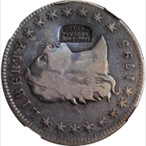 This is the accurate story behind Houck's Panacea. Many seasoned researchers know that not everything in print is accurate. Sometimes an erroneous bit of information is put in writing, then repeated and eventually it becomes an accepted fact. Such is the case with the story behind the Houck's Panacea counterstamp.
This is the accurate story behind Houck's Panacea. Many seasoned researchers know that not everything in print is accurate. Sometimes an erroneous bit of information is put in writing, then repeated and eventually it becomes an accepted fact. Such is the case with the story behind the Houck's Panacea counterstamp.
The Houck's Panacea stamp is certainly one of the most popular counterstamps yet far from the rarest. There are likely well over one hundred known stamped coins with most of these being half dollars. There may be fewer than ten stamps on early dollars, of which there are at least two stamps found on flowing hair dollars.
Half dollars dating from 1829 to 1836 comprise most of the stamped coins, therefore capped bust type half dollars. There are a few draped bust halves with the stamp. There are at least six early quarters known to have the stamp. In addition to the United States coins, the stamp is found on France 5 Francs, Mexico/Spanish 1 and 2 Reales, Brazilian 960 Reis and a Prussian Taler. If a counterstamped coin issued after 1836 is found, such as a Seated Liberty coin, it would be a rare use of the stamp. To be sure, Houck did not waste his stamp on such low denomination coins as large cents.
Virtually all coins but the early dollars and foreign coins have the stamp in the same location, vertically situated in front of Liberty's face. Brunk indicates that there are two varieties of the stamp, the common one as shown within this article and another with a serrated top. Only one is known to exist.
The Houck's Panacea stamps, used for advertising, were most likely made just after Houck gained approval for his patent, which was in 1833.
It is uncertain why Houck stopped stamping coins after 1836. Houck did continue to advertise in newspapers and flyers and did so through at least 1842. He also issued his own paper notes to advertise his product and location.
So, who was the person behind the special formula, the advertising and the stamp? This is where the erroneous information begins, and this seems to go back well over one hundred years. Note that the full names of the key people involved are used throughout to help avoid confusion and make clear the actual story.
Jacob Houck (no middle name used or found) was born in 1792 near Frederick City, Maryland. In 1811 he married Elizabeth Trisler and they raised a family of three boys. Jacob Houck was a merchant and had a dry goods store and lab
in Baltimore for many years. Jacob Houck died in 1850.
I was unaware of the scrip notes. What a great pairing for an exhibit! -Editor
For more information on the John Reich Collectors Society, see:
https://www.jrcs.org/
ODE TO A SQUISHED DIME
The Writer's Almanac for Wednesday, May 4, 2022 published a poem by Charles Darling about an elongated dime machine "At the County Fair, 1956" -Editor
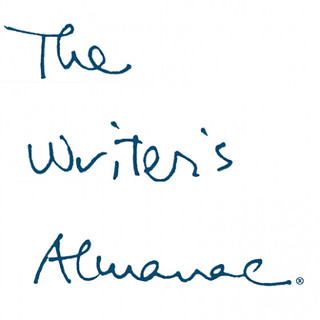 At the County Fair, 1956
At the County Fair, 1956
by Charles Darling
For a nickel, a machine
called An Expression of Faith
would take your dime
and squash it.
All tubes and gears and lights,
the thing would groan, squeak,
fart, smoke, and finally drop
a little silver oval in your hands,
hot as a pistol,
with Jesus's face on one side
and the Lord's Prayer on the other.
I took my medallion
home for Grandma,
but she wouldn't keep it
because it was Catholic
and had trespasses
instead of debts
and left out the part
about the kingdom
and the power and the glory.
She gave it back
and I went downtown
and set it on the railroad track.
And after the train went by
I had a piece of silver
smooth as glass and that
says something about
power and glory, by God.
To read the complete Writer's Almanac issue, see:
The Writer's Almanac for Wednesday, May 4, 2022
(https://www.garrisonkeillor.com/radio/twa-the-writers-almanac-for-may-4-2022/)
ANS INDIAN PEACE MEDAL COLLECTION
An ANS Pocket Change blog article by Oliver Hoover examines the development of the Indian Peace Medal collection at the ANS. Here's an excerpt - see the complete article online. -Editor
When looked at through the numismatic lens, the Indian peace medals in the extensive collection of the American Numismatic Society tell the interesting and sometimes sordid story of the development of the U.S. Mint as both producer and marketer of medals for official purposes and for collectors. Due to the association of many of the medals with the names of Native American leaders who owned them before they entered the ANS collection, the medals also tell the personal stories of triumph and tragedy experienced by their original owners. The medals also have a third facet that is often overlooked. Their accession histories tell the story of the early American Numismatic Society and of the extraordinary cast of characters who came together for the purpose of developing the Indian peace medal collection between 1883 and 1927. The often-collective nature of the work undertaken by members of the Society in this period illustrates the broad interest of the material to people not only as numismatists, but as Americans with a sense of their country's history.
Figure 1. Small silver James Madison Indian peace medal donated by Daniel Parish, Jr
The first original silver peace medal to enter the collection was a James Madison of the small size normally reserved for distribution to leading Native American warriors than to important chiefs (Fig. 1). It was included along with 29 U.S. Mint restrikes of Indian peace medals in bronzed copper and white metal donated by Daniel Parish, Jr. in 1883. Parish had been a prominent member of the Society since 1865 and assumed the office of President in the same year as his gift of the peace medals. He continued to guide the ANS until ill health caused him to retire from office in 1896. His leadership was so widely appreciated by the council and the membership that he was elected Honorary President for Life in 1908. He not only provided the constitution upon which the Society would advance into the future, but also lay the foundation of the ANS collection of both original medals and Indian peace medal restrikes. Upon these first 30 medals the Society would ultimately build the largest institutional collection of Indian peace medals in the world.
Figure 2. Large oval silver George Washington Indian peace medal donated by Stephen H. P. Pell.
Daniel Parish, Jr. died in 1914, but the spirit of his 1883 gift lived on and seems to have taken a greater hold on the Society. At the end of 1914 and continuing through 1915, the ANS acquired the important collection of original silver Indian peace medals formed by Stephen H. P. Pell. He had been a member of the Society since 1907 and is perhaps best known for his restoration of Fort Ticonderoga in upstate New York. Upon determining that the proper place for the medals was in the ANS cabinet, Pell donated five pieces outright, including an impressive engraved 1793 George Washington oval medal (Fig. 2) and then took the novel step of selling thirty more to members by subscription. The subscribers would then donate their medals to the Society in their own names.
Subscription for the Pell medals seems to have had a very social aspect among the ANS membership and many have the names of four or five individuals attached to them. Most remarkable about these names is that they frequently belong to elite members of contemporary society who could easily have purchased the medals and donated them as individuals, rather than as part of a subscriber group. Subscribers included such figures as the New York philanthropist William Church Osborn, who is perhaps best known for his leadership of the Metropolitan Museum of Art and his personal collection of impressionist and post-impressionist paintings; Jacob A. Schiff, the head of the international banking firm Kuhn, Loeb & Company; and Moritz Wormser, the New York banker and numismatist who went on to found the famous New Netherlands Coin Company in 1936. Even Abraham G. Mills, of early baseball fame and controversy, appears among the subscribers for a middle-size James Madison medal. All of this suggests that Pell's Indian peace medals were not only objects of great interest in 1915, but that many people also wanted to be seen to appreciate them. Motivation may perhaps be found in the fact that at the same time that the Pell medals were entering the ANS collection in New York, the Panama-Pacific International Exposition—a world's fair that celebrated the realization of American manifest destiny and heavily romanticized the Native American—was taking place in San Francisco.
Figure 3. Bronzed copper U.S. Mint restrike of a large James Buchanan Indian peace medal from the J. Coolidge Hills bequest.
Even before the grand event of the Pell medal acquisition, the ANS was poised to gain a further 20 Indian peace medals—mainly bronzed copper restrikes—when J. Coolidge Hills died in 1913 (Fig. 3). Hills had been an active member of the Society since 1893 and was a prolific collector of medals and decorations. His will stipulated that all 3,094 objects in his collection were donated to the Wadsworth Atheneum in his hometown of Hartford, Connecticut, but Hills included a proviso that almost prefigures the plot of Brewster's Millions. In order to retain the collection, all of the medals and decorations had to remain on permanent display. If this could not be done, the collection had to be transferred to the ANS. The Wadsworth Atheneum—an art museum not dedicated primarily to numismatics—managed to abide by the requirements of the bequest until 1967, when it was decided that it had other uses for the display space taken up by the Hills material and the collection was transferred to the American Numismatic Society. Together with the pieces donated previously by Daniel Parish, Jr., the medals in the Hills bequest account for the bulk of the Society's collection of 19th-century Indian peace medal restrikes.
To read the complete article, see:
The Development of the ANS Indian Peace Medal Collection
(https://numismatics.org/pocketchange/peacemedaldev/)
To read the earlier E-Sylum article, see:
INDIAN PEACE MEDALS AT THE ANS
(https://www.coinbooks.org/v25/esylum_v25n17a26.html)
JEWISH PRESENTATION MEDALS
Michael Oppenheim of Vancouver BC submitted these notes on an interesting group of Jewish presentation medals offered in an upcoming Goldbergs sale. Thanks - a great variety of pieces. -Editor
I have been collecting presentation medals for many years, and a number of the Jewish-related medals that were given to significant persons in entertainment and politics will be coming up for auction in the Judaica and the Entertainment sections of The Collectibles Auction
by Ira and Larry Goldberg on May 24, 2022. I thought that these could be of interest to your readers. Included among the material are the following five unique items.
1. A rare example of the silver State of Israel Bonds medal with hanger (CM 24a, 59mm, 115g) is inscribed to the famous Jewish comedian Jack Benny. It is the first issue type, with the signature of the Prime Minister of Israel Levi Eshkol. Jack Benny (Benjamin Kubelsky) was probably the most prominent spokesman for Israel Bonds during the early years of Israel's existence and was recognized for his decades-long work many times. This medal first appeared in a William Rosenblum auction of September 1995.
2. A large (45mm) gold medal was given to the Labor leader George Meany in 1978. The gold Theodore Herzl Award is the highest award of the Zionist Organization of America. Other important recipients of the award include President Harry Truman and Prime Minister Winston Churchill. The obverse of the medal has a large portrait of Herzl and the reverse has an elegant engraved inscription: To George Meany, faithful friend of Israel, for his devotion to America and its Labor Movement, for his support of the Jewish people's struggle to re-establish the Jewish state, and for his aid in defending Israel against the enemies of Democracy. Washington D.C., June 6, 1978.
George Meany (1894-1980) was a prominent union leader and political figure in the 1960s. He founded the AFL-CIO in 1955, served for 25 years as its first president, and was a major supporter of the Kennedy Administration and the Democratic Party in that period.
3. This item consists of a red leather covered box containing three gold pieces that were presented to the orchestra conductor Leonard Bernstein in 1968. A small silver plaque on the box is inscribed: To Maestro Leonard Bernstein in deep appreciation for the unforgettable festive concerts celebrating the 20th Anniversary of the State of Israel––The Israel Philharmonic Orchestra Tel Aviv, 2nd May, 1968.
Inside the box are an Israel 100 Lirot Reunification of Jerusalem 1968 gold coin, and two gold medals (each approximately 29g, 22K) celebrating the victory of the 1967 War. The box first appeared in a Sotheby's, New York auction of The Property from the Estate of Leonard Bernstein,
Dec. 10 and 11, 1997, lot 13.
4. A solid gold Boston Fireman's (Fire Chief) badge is engraved to Louis B. Mayer (The King of Hollywood
) dated May 14, 1926. It was presented to him at a large, public ceremony at the end of a long publicity trip he made for his silent movie, The Fire Brigade: The Heroes of Peace.
To publicize this late silent movie Mayer rented a railway car to travel throughout America, from the West Coast to the East Coast. During that trip he met with representatives of Fire Departments in different cities to advertise the movie. Boston was especially important to him, because it was there he began his career in the movie industry. This badge earlier appeared in a Butterfield and Butterfield auction in 1996 (lot 1247).
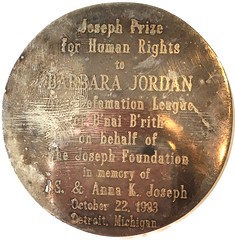 5. An early example of the Joseph Human Rights Award of the Anti-Defamation League of B'nai Brith, was given to the prominent Democratic politician and Civil Rights leader Barbara Jordan. She was the first African-American elected to the Texas Senate since Reconstruction and the first Southern African-American woman elected to the U.S. House of Representatives. The silver medal (59mm, 6mm thick, 170g) is inscribed:
5. An early example of the Joseph Human Rights Award of the Anti-Defamation League of B'nai Brith, was given to the prominent Democratic politician and Civil Rights leader Barbara Jordan. She was the first African-American elected to the Texas Senate since Reconstruction and the first Southern African-American woman elected to the U.S. House of Representatives. The silver medal (59mm, 6mm thick, 170g) is inscribed: Joseph Prize for Human Rights to Barbara Jordan, Anti-Defamation League of B'nai B'rith, on behalf of the Joseph Foundation…October 23, 1993, Detroit, Michigan.
The award is in a folder, which also contains a large (59mm) silver Israel State medal that commemorates the Jewish war for freedom from Roman rule that ended with a heroic stand at Masada in 73-74 CE.
Further information about these items and others in the group will be on-line starting May 15 on the Ira and Larry Goldberg website as well as with Live Auctioneers.
LOOSE CHANGE: MAY 8, 2022
Here are some additional items in the media this week that may be of interest. -Editor
As noted earlier, the Bureau of Engraving and Printing is planning a move from Washington, D.C. to a new facility to be built in Maryland by 2027. Thanks to Scott Barman for linking to the article in his Coin Collector's Blog. -Editor
The U.S. Bureau of Engraving and Printing, which prints U.S. currency, is moving forward with plans to build its new facility in Maryland, Gov. Larry Hogan announced Wednesday.
The bureau is expecting to house at least 850 workers on site, with 600 additional employees working remotely, the governor's office said.
The 104-acre site, located at the U.S. Department of Agriculture's Beltsville Agricultural Research Center in Prince George's County, has been officially transferred to the Department of the Treasury.
Despite the glamor of billions in banknotes, the BEP is a factory kept running by blue-collar factory workers. I wonder how they will be able to commute to their jobs once the facility relocates to what is currently a rural area. And will the new facility accommodate tours for the visiting public? Will the public still come if the facility is no longer in the tourist-rich D.C. area? -Editor
To read the complete article, see:
Federal Money Printing Facility Moving Ahead in Maryland
(https://www.nbcwashington.com/news/local/federal-money-printing-facility-moving-ahead-in-maryland/3036896/)
To read the earlier E-Sylum articles, see:
LOOSE CHANGE: MARCH 31, 2019 : BEP To Build New D.C. Facility
(https://www.coinbooks.org/v22/esylum_v22n13a32.html)
MORE ON THE POTENTIAL BEP MOVE
(https://www.coinbooks.org/v22/esylum_v22n14a16.html)
To read the Coin Collector's Blog article, see:
Weekly World Numismatic News for May 1, 2022
(http://coinsblog.ws/2022/05/weekly-world-numismatic-news-for-may-1-2022.html)
Another pair of numismatic fugitives is on the loose. According to Coin World, the FBI is looking for two former Northwest Territorial Mint officials. -Editor
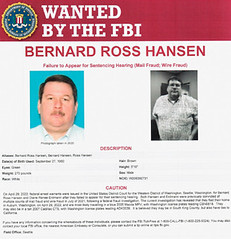 The former owner of the now bankrupt Northwest Territorial Mint in Auburn, Washington, and his vault manager and girlfriend, both convicted in 2021 of multiple counts of mail and wire fraud connected with the sale and storage of millions of dollars in gold and silver, went on the run after failing to appear for sentencing April 29 in federal court in Seattle.
The former owner of the now bankrupt Northwest Territorial Mint in Auburn, Washington, and his vault manager and girlfriend, both convicted in 2021 of multiple counts of mail and wire fraud connected with the sale and storage of millions of dollars in gold and silver, went on the run after failing to appear for sentencing April 29 in federal court in Seattle.
Bernard Ross Hansen, 62, and Diane Renee Erdmann, 49, were placed on the FBI's Most Wanted list after failing to make their scheduled court appearance.
To read the complete article, see:
FBI seeks two former Northwest Territorial Mint officials
(https://www.coinworld.com/news/us-coins/fbi-seeks-two-former-northwest-territorial-mint-officials)
For those who may have forgotten, in February 2015 the U.S. Marshalls captured SS Central America figure Tommy Thompson and his longtime assistant, Alison Anteiker, after more than two years on the lam. -Editor
To read a new USA Today article, see:
Deep-sea secrets and the 'Ship of Gold': Why a treasure hunter sits behind bars as bounty tours nation
(https://www.usatoday.com/story/news/nation/2022/05/08/treasure-hunter-gold-shipwreck/9663123002/)
To read the earlier E-Sylum articles, see:
SS CENTRAL AMERICA FINDER TOMMY THOMPSON FOUND
(https://www.coinbooks.org/esylum_v18n05a09.html)
NORTHWEST TERRITORIAL MINT OFFICERS ARRESTED
(https://www.coinbooks.org/v21/esylum_v21n18a11.html)
Pablo Hoffman passed along this 2017 Atlas Obscura item about Spencer Clark's portrait on the 5 Cent Fractional Currency Note. Thanks. -Editor
IN 1866, SPENCER M. CLARK, then Superintendent of the National Currency Bureau, made a daring decision: to print his own face on U.S. currency.
Clark, who served as Superintendent from 1862 to 1868, had no authorization from his superiors to do this. But U.S. paper bills were in flux because of the recent introduction of fractional money, and as the supervisor of the new bills, he was in a unique position to influence the design.
To read the complete article, see:
The bill was supposed to feature explorer William Clark instead.
(https://www.atlasobscura.com/articles/treasury-official-us-bill-fractional-money-spencer-m-clark)
Another Atlas Obscura item (from 2016) found by Pablo Hoffman. Thanks! Great reading. -Editor
BLUR YOUR EYES, AND THE BANKNOTE above looks normal enough. It has the right proportions. It's covered in intricate line drawings, so as to discourage counterfeiting. It's got serious-looking slogans and strongly penned numbers. If someone passed it to you across a counter after a long night, you might not look twice.
Focus, though, and you'll notice a few weird things going on. A panel on the left side shows a bony, balding person dressed in a tattered American Flag. Across the top, a dragon rides a carriage through the streets, crushing pedestrians willy-nilly. The right side sports a donkey defecating into a monkey's top hat. And along the bottom, a dung beetle with a human face rolls a poop ball emblazoned with the bill's weird denomination: 75 cents.
To read the complete article, see:
The Best Political Cartoon In History Is This Fake Banknote from the Panic of 1837
(https://www.atlasobscura.com/articles/the-best-political-cartoon-in-history-is-this-fake-banknote-from-the-panic-of-1837)

